Posts Tagged ‘Ken Waltzer’
Sunday, April 17th, 2016
BY CAROLYN YEAGER
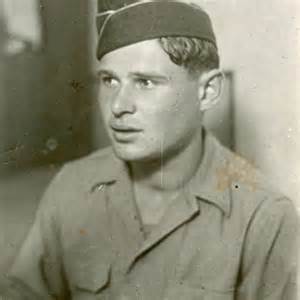
This is a picture of Paul Argiewicz used by the Wisconsin Veterans Museum but with no description. Considering he’s wearing a US Army cap it has to be from after 1950, which would make him over 25 years of age.
Remember Paul Argiewicz? He’s the guy I wrote about here because it’s widely claimed he’s in the Famous Buchenwald Liberation Photo, which he is not. But there are a lot of things wrong with the Paul Argiewicz story – claiming he is in that photo is just one of them.
Christine Miller has observed that being forced to believe holocaust survivor’s stories has made Western man irrational. Paul’s story is as irrational as any, especially when it comes to the simple act of adding together two-digit numbers. So let’s start there.
Paul’s date of birth is always given as Aug. 6, 1925 in Bielsko, Poland. He grew up using his mother’s name, Argiewicz, because his parents were not formally or officially married. The family included two older sisters. He told interviewers that he only went three and a half years to grade school. He was arrested in 1941 by his own reckoning, when he would have been 16 years old.
However, his story, wherever you look either online or in the book about him, states that he was age 11 at the time of his arrest by the Nazis, and in his own obituary written or approved by his family it says “he was arrested at age 10 by the SS for stealing bread for his starving family in the Jewish ghetto.” [The ‘stealing bread for starving family’ part is obviously fiction, but Paul was known as an emotional person who cried easily and liked to create as much sympathetic reaction in his listeners as possible.]
So what’s going on with this man? And with his family and biographer? Can’t they add? It’s apparent that holocaust survivors have become so complacent because of their experience that anything they say will pass that they actually believe “anything will pass.” Even to the point that if you’re born in 1925 you can be 11 years old in 1941. Think about it. The year of Paul’s arrest is not always mentioned as it is here, but we all know the camps were liberated in 1945, and we know he turned 20 in that year. Precisely, he was 19 on April 11, 1945, four months shy of his 20th birthday … not 14.
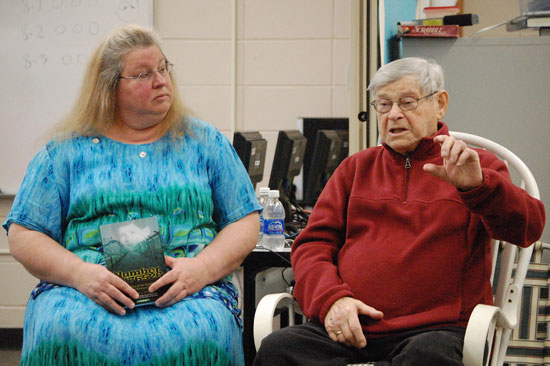
Deanne Joseph Ebner (left) who wrote the book “Number 176520: The Story of Paul Argiewicz ”A Teenage Holocaust Survivor” appeared with Argiewicz in 2012 at Riverview School.
What makes this age imposture important enough for Paul and his biographer to try to slip it past most readers? The craving for attention. Paul separates himself from the crowded field of fellow “survivors” by billing himself as a “child survivor.” He describes himself as being still a teenager when he was released … which he was, even if just barely. But he wanted to be younger still … a child. And what is surprising is that he basically has gotten away with it! I have not come across anyone questioning the claim that Paul was 11 when he was arrested, even though he was born in 1925. [I notice he told the Wisconsin Veterans Museum interviewer on page 7 that he was born in 1933!]
This type of “pass” can be better understood from a question by a poster commenting to another “survivor” who claimed he rode in a packed train car for 6 days with no food or water and no stops:
Did anyone die midway in the six day train ride with no food/water? I’m by no means doubting, just asking a question. As someone has mentioned below, you CAN survive without water for about a week.
God forbid these young people should doubt anything said by a holy survivor, no matter how unconnected to reality. The “survivor” answered he didn’t recall any deaths. But the point being, we don’t ask questions – we’re ashamed or afraid to question – and it leads to utter nonsense.
After doing more than a bit of research into Paul Argiewicz, I’ve come to the conclusion that there is also a felt need by him to gain as much sympathy as possible from being a tender 11 years of age to avoid what may be legitimate questions about what he actually did during that 4-5 years in German camps. I’m quite sure that Paul was never starved nor even mistreated during his time in the camps. He was more likely quite the collaborator. The photo on his German drivers license dated June 1946, only one year after liberation, shows a healthy young man with no sign of having endured any trauma whatsoever. He’s wearing an expensive leather jacket or coat and looks untroubled and at peace with himself.
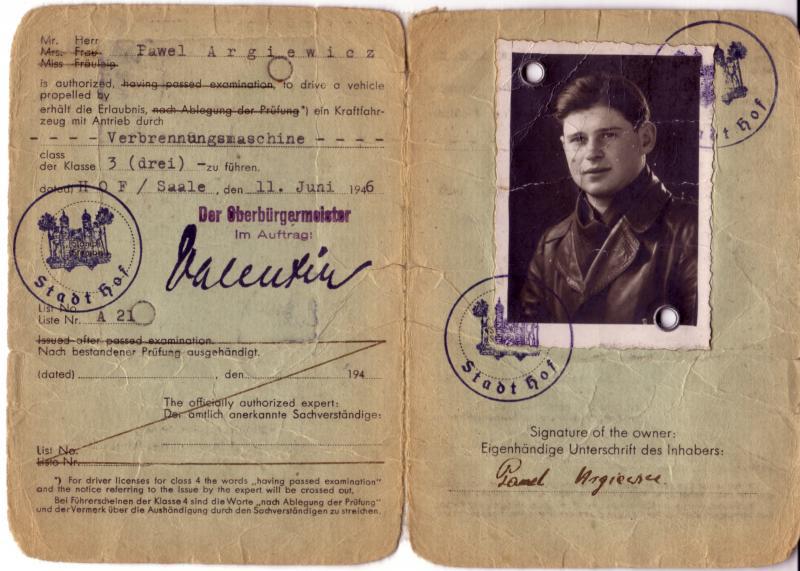
German Drivers License issued to Paul Angiewicz in June 1946. He was obviously living in Germany at the time and looking prosperous.
The same craving for attention also accounts for his willingness to falsely identify himself in the Famous Buchenwald Liberation Photo. Argiewicz named himself as the person 3rd from the left in the 3rd bunk up from the bottom in 2008, the same year his book came out. Everyone in that photo is self-identified, and it began after Elie Wiesel identified himself in it in 1983. Before that, no one was identified. After research by a number of people, including myself, it turns out the only correctly identified person is 16-year old Michael (Nikolaus) Grüner in the lower left. Even Argiewicz’ nephew, Murray Matzner, says his uncle is not in the picture, but excuses his uncle’s lies with the charge that he was under the influence of the woman who wrote the book about him, Deanne I. Joseph. Matzner wrote a comment at Scrapbookpages Blog in 2015 to a post that originally appeared in 2010.
It is obvious that my uncle Paul Argiewicz is not the person indicated in the photo. It looks nothing like him, and is in fact proved not to be him in his own memoir book photo on the opposite page where a drivers license photo one year later does not resemble this face at all. In particular, he did not have eyebrows that curved so far around his eyes.
The assertion that he is present in this photo was nonexistent until 2008, the year his memoir book was published. Since his ghost written book gets so very many facts and stories wrong, as the website associated with book sales also does, and stains a courageous man of integrity who is greatly missed because he is no longer with us, it appears that the false assertion is associated with the factually compromised book.
I have also seen a photo where it is the man one bunk lower, and to the left, a sleeping man facing away from the camera, who is indicated as my uncle with a vertical arrow.
I don’t know what it is with this photo. The individual indicated as Mr. Wiesel appears to have a receding hairline although a published image of him at age 15 prior to deportation does not have such a hairline. I believe that neither he or my uncle appear in the photo, and it appears to me that at least in the case of my uncle, that it was someone else pushing for him to be present.
My uncle was a wonderful, warm, caring, courageous, person who inspired so many with his exceptional love of life and people… but he isn’t in this photograph.
RIP, uncle. Your love lives on.
Comment by Murray Matzner — April 3, 2015 @ 1:03 pm
Okay Murray, except that Paul was photographed at one of his gatherings holding an enlargement of the famous photograph, indicating that he certainly wanted people to believe that he was in the picture. He, and maybe more so his wife Sheryl have been fully engaged in that fantasy.
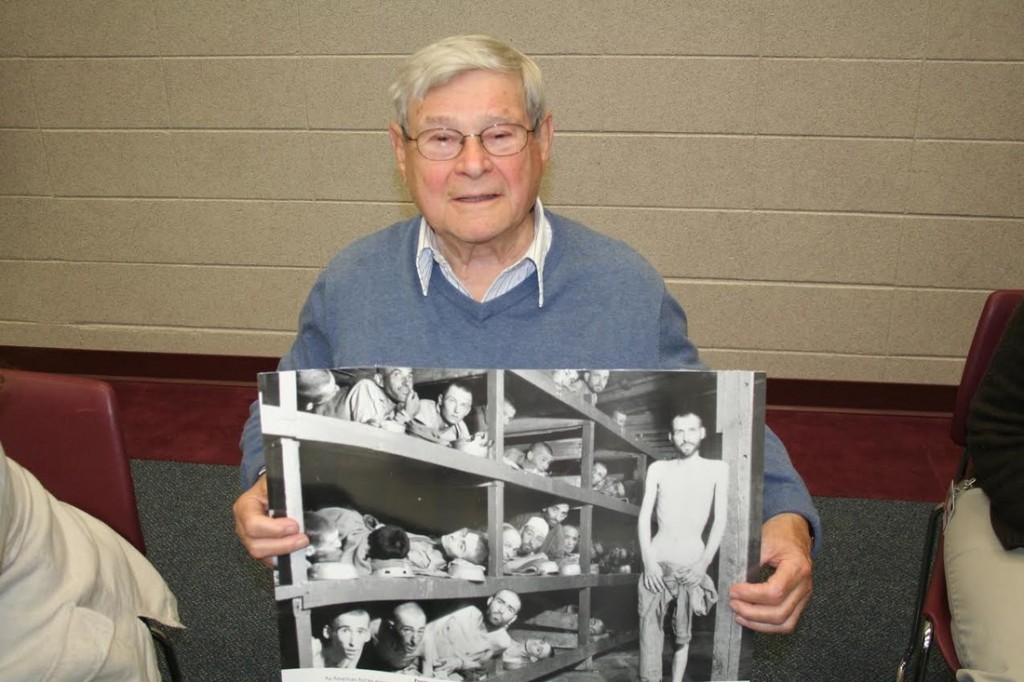
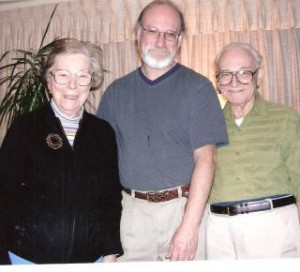
Lucy Argiewicz Matzner (Paul’s “beloved” sister), her son Murray and husband Robert.
Murray’s father, Robert Matzner, (left, in green shirt) who married Paul’s sister Lucy, was born in 1926 in the same Polish town of Bielsko. He has written his own holocaust memoir, titled Prisoner 19053. I wonder how many falsehoods that book contains? Hopefully not as many as Paul’s. But I think Murray may be trying to keep peace in the family by blaming the falsehoods in Paul’s book on the author. Clearly, Paul’s wife Sheryl had a lot to do with the writing of the book, and the three are often pictured attending book-promotion meetings together.
* * *
After Paul’s death in December 2013, some controversy broke out on the Amazon book advertisement page among the “reviewers.” Specifically “BTI” wrote:
In Memory of Paul
By BTI on June 22, 2015
Every story in this book is documented in numerous recordings, CDs, and videos as coming from Paul Argiewicz himself – his face, his words, his voice. It is Paul’s account of what happened to him as a young boy in the Nazi concentration camps. Anyone who knew Paul, loved Paul, was inspired by Paul, and truly desires to protect the memory of Paul Argiewicz will boldly stand witness against the frauds of the world (be they Holocaust deniers, anti-Semites, or vindictive relatives). All of the above-mentioned records of Paul’s testimony will soon be posted online. Be watching. May the evil ones be silenced by their own arrogance.
Cindy Nicoletti, Paul’s stepdaughter, posted a “review” by Dave Kasiske. In it he revealed:
“I am blown away that Paul’s nephew would come out now after Paul’s death. He cannot say the man in the picture is not Paul because the poor young Paul was probably close to death after experiencing starvation. Paul would say “Dave”, I can’t explain it to you how it was to cry at night because of starvation and never seeing my loved ones again.”
And
“Paul was always in tears when he told the story of his sister Lucy. Lucy is the mother of “Murray”, the one who is attacking Paul’s story. That brings the question to my mind, why would anyone who is Jewish go on a antisemitic spur? Even when I would sit with Paul at his kitchen table, the tears would flow when he talked about Lucy. Anyone who has the guts to attack a family member who survived the horrors of the Holocaust should seek psychological help.”
Yes, it takes guts indeed to stand up against holocaust lies, Dave. Maybe someday you’ll be able to do it. But now take a look at this from stepdaughter Cindy to see who is pushing Paul’s false story.
The owner of Sunless Expressions would like to recommend her stepfather’s book:
Number 176520
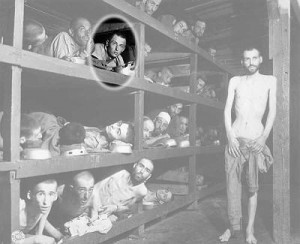
This famous photograph was taken a few days after the liberation of Buchenwald and appeared on the cover of a popular national magazine in the 1960s. Paul is pictured (circled) here on the third bunk from the bottom, the third person from the left (with his food bowl that doubled as a pillow).
Cindy, Owner and Founder of Sunless Expressions is the step daughter of a man with an astounding and miraculous life story. Paul Argiewicz was an eleven year old child in 1941 when he was arrested in Poland by two Nazi SS officers. His crime? Paul had stolen two loaves of bread to take to his starving family in the Jewish ghetto. Separated from his family and everything he loved, he would spend the next four years of his young life working as a slave laborer in seven different concentration camps. From Auschwitz to Blechhammer, Gross Rosen, and Buchenwald, Argiewicz; defied all odds by surviving one of modern history’s most unimaginable atrocities against humanity: the Holocaust.
Sunless Expressions is proud to recommend Number 176520 ~ The Story of Paul Argiewicz, a Teenage Holocaust Survivor. With over 16 pages of full-color photos, original camp documents, and other visuals, Number 176520 has quickly become a highly revered and sought-after Holocaust resource in schools, bookstores, libraries, museums, and homes. Visit www.paulsstory.com to purchase and/or learn more about the book that has been inspiring countless readers around the world.
We regretfully announce Paul passed away December 11, 2013.
Paul’s last public appearance before his death was on April 29, 2013 at the U.S. Holocaust Museum’s 20th Anniversary Ceremony with speakers Elie Wiesel and Bill Clinton. Here he is photographed with his wife Sheryl and grandson Jordan, who are active in furthering the mythical version of his life. In another photo he is showing off his Auschwitz tattoo “176520,” as they were all doing that night (except for Wiesel, of course). Yes, they were there, but what they did or did not experience cannot be proven by a tattoo.
There are no excerpts available from his book at Amazon, but I found this one and am going to quote it in full here. It gives a good idea of the fictional style found in most holocaust survivor stories – no dates, times, names – the events, as they are, exist as if floating in space, but are meant to evoke as much emotional sympathy, shock and pity as possible toward the subject. Notice the similarities to Elie Wiesel’s Night, which must have been used as a model, for example when the fellow arrestee advises a confused Paul to say he is 18. However, Paul’s “ghostwriter” handled the impossible jump from age 11 to age 18 by having the SS man play it as a sort of joke. And since Paul says he spoke perfect German, that warmed the heart of the otherwise cold officer. The whole scene is a lie …
At Scrapbookpages Blog, the blogger wrote in March 2010: “Argiewicz says that he had an advantage because he could speak fluent German since his mother was from Bavaria, a state in Germany.” Of course, we know his mother and father were both Polish, and Ms. Joseph comes up with a different story: That Paul associated with Gentile youths when he snuck out of the ghetto every other night for a year (!) and learned German that way. But weren’t there Poles along with Germans outside of the ghetto? This is not explained, of course, but left to your imagination. Apparently a German baker and his children just loved little Paul and gave him bread and German lessons too.
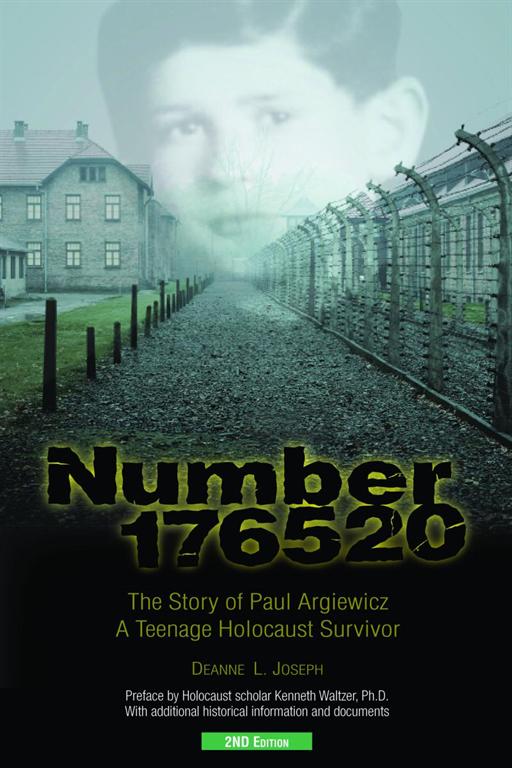
Look how dishonest the book cover is. Paul was not a young child in the camps but 16 to 19 years old. He wasn’t even in Auschwitz except for 2 days, then, according to him, sent to Blechhammer, and spent the last 4 months at Buchenwald.
The preface to the book is written by our old friend, Professor Kenneth Waltzer, and in it he gives “historical documentation.” I would really like to see that. I should order the book and write more about this later; the only thing that stops me is that you and I both know there is no end to this stuff. One thing leads to another. So we’ll see, but for now, enjoy this excerpt. You will notice that not a single person has a name except Paul.
* * *
Deanne L. Joseph’s moving new memoir, Number 176520 –The Story of Paul Argiewicz, a Teenage Holocaust Survivor, poignantly recounts one child’s journey through the terrors. With a preface and historical documentation provided by renowned Holocaust scholar, Professor Kenneth Waltzer (Director of Jewish Studies, Michigan State University), Number 176520 is quickly becoming an invaluable resource for students of the Holocaust.
Following is an excerpt from the book:
Paul and his family lived in the ghetto for about a year. In spite of the dire circumstances, his boyish, adventurous nature remained. He removed the identification patch from his clothing and sneaked out of the ghetto [Sosnowiec, not Warsaw -cy] through an opening in the barbed wire fence. It was an act of defiance that would have landed him at the end of an executioner’s gun had he been caught, but somehow he was able to pull off this rite two to three times a week. [I don’t think an 11-year old boy would be allowed out alone at night by his loving parents, do you? Neither would he have been shot dead if caught.-cy]
Being the gregarious child that he was, he made friends with some gentile children on the “outside.” They did not seem to mind that he was Jewish, and some of their parents even tried to help him in small ways. The father of one of his new friends owned a bakery. The man’s sympathetic conscience obliged him to turn a blind eye, allowing Paul to steal freshly baked bread from his store twice a week. The ritual continued for a year. Sometimes the determined young scavenger managed to find potato peels or other small provisions of vegetables and was always faithful to rush his smuggled goods back to his hungry family behind the fence.
Eventually, Paul became so comfortable in his excursions that he inadvertently lowered his guard and came face to face with disaster. Returning to his family with a pair of stolen loaves of bread, he was approached by two SS officers.
“Where did you get that bread?” they demanded. Paul had never been so close to the enemy. He stood, accused and frozen.
“Come with us!” The order was stern and curt. They snatched the bread from his hands. The pounding of his heart intensified until he thought it would surely break through his chest. He could barely breathe. He felt a hard, squeezing pressure on his arm — the grip of a Nazi. He had the sensation of walking very quickly, although he was unable to feel his legs. Were his feet touching the ground? Were they even moving? He heard only the sound of the officers’ boots clacking with each step on the hard street beneath their feet. His eyes burned as if on fire, and blurred images of his family flashed through his rattled brain. What would they think? Would he ever see them again? Were these men going to kill him? Paul fought to restrain the tears pooling in his eyes. He was only a child — his life was supposed to be ahead of him, not behind.
They arrived at their destination: an old schoolhouse that had been converted into a transitory evaluation and detainment center, the Durkankslager. He was taken downstairs to the basement, the “dungeon.” It was filled with people standing in lines. Everywhere were the familiar Jewish identification patches. The Nazis pushed him into place with the others. He looked around at the detainees, predominantly grown men. He did not see any other children in the crowded space.
An SS officer sat upright on a stool at the front of the room, one leg raised and bent at the knee with his booted foot confidently perched on a table. Behind him was a desk filled with papers. As each of the accused men made his way to the front of the line, he was questioned by the man on the stool, evaluated, and sent into a group either to the right or to the left. Paul was not sure why the men were being divided, but as he drew closer to the evaluating officer, he was overcome with a sense of doom. His mind fired rapid, disconnected thoughts. I’m only a child . . . perhaps if I tell them I’m only 11 years old . . . maybe they will have pity and let me go back to my parents.
Without warning, a man behind him in the line kicked the back of his leg. He leaned into Paul’s ear and spoke quietly but firmly.
“Don’t tell them your real age. Tell them you’re 18.”
How did he know what I was thinking? Paul wondered.
He arrived at the head of the line. No longer did anyone stand between him and the “judge.”
“Name?” “Paul Argiewicz.”“Age?” “Eighteen.”
The words rolled off his lips in perfect Bavarian German. The officer looked up. His dusky eyes examined the youth before him. His brow furrowed, and he observed the boy for a moment. Paul felt as though he had been suspended in space and time. The moment seemed to last an eternity. Surely, he was exposed . . . guilty . . . he had lied . . . to an SS officer! The penalty for such an offense was execution.
“You speak German?” The officer seemed amused. “Yes,” he responded once more in the language he had learned from his playmates.
“You speak with a Bavarian accent. Why?” “My mother is from Bavaria,” he lied again. For another endless moment, the man’s eyes pierced him. Paul was able to manage a convincing expression. Finally, the harshness of the Nazi’s sharply featured face faded, yielding to a smile and a chuckle.
“Go over there,” he said, nodding his head to his left.
Paul moved in the direction of the nod, but he did not understand the purpose of separating the men. Would he be sent to work or to the grave? None of the men seemed to know the fate that awaited them.
They remained in the detainment center for a few more days. Each day they were given small rations of bread and a cup of water. Paul allowed his mind to escape into a place of refuge and peace. He comforted himself with thoughts of his family, memories of good times they had shared, life in Phella’s beautiful home, and the hope that maybe he would soon be returning there.
In the corner of his eye, Paul perceived movement through a window in the damp stone wall. He turned his head to look through the dusty glass. Just beyond the tall barbed-wire fence, his father stood, his eyes scouring the room through the wire and glass. Noah’s eyes found Paul’s. His hand flew over his head waving to his son, his familiar penetrating eyes filled with longing. He held his hand still for a moment and then let it fall limp to his side. He stood motionless, his gaze fixed on his child. [This is a totally fictional account intended to create poignancy. Paul never saw his father through a window.]
Paul’s heart raced within him. An overwhelming urge demanded that he jump to his feet and run to the window. He dared not. To do so would jeopardize not only his fate but also now his father’s. Separated by brick and mortar, barbed wire and guns, and the merciless cruelty of the human heart, father and son looked upon each other for the last time. In that sacred moment, they knew that the bond they shared was beyond man’s reach; it was a bond protected and preserved in eternity. Still, the 11-year-old was overcome by the realization that he might never again feel the loving touch of his father’s strong hands or hear the sound of his voice.
On the cold, hard floor, Paul covered his face and wept. His father was gone. [End of excerpt]
5 Comments
Category Featured | Tags: Tags: Auschwitz tattoos, famous Buchenwald photo, Holocaust fraud, Ken Waltzer, Murray Matzner, USHMM,
Social Networks: Facebook, Twitter, Google Bookmarks, del.icio.us, StumbleUpon, Digg, Reddit, Posterous.
Sunday, December 6th, 2015
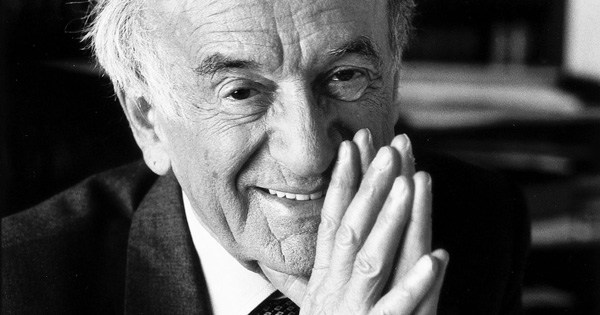
Elie Wiesel laughing over the big joke he’s playing on the public.
By Carolyn Yeager
Here they are! These three articles, read in order, will explain why Elie Wiesel was not at Auschwitz or Buchenwald. If you carefully read and comprehend what is in these three articles, you will understand why this site is called Elie Wiesel Cons The World and you will be able to explain it to other people in a way that they are unable to refute. Do you see any real refutation (with sourced material) brought by visitors to this site? If you do, please let me know because I missed it. The three articles are:
1. When did Elie Wiesel arrive at Auschwitz ? Could he have received the number A-7713? This article proves that the answer to the second question is “no” … which makes everything else fraudulent and impossible.
2. Gigantic Fraud Carried Out for Wiesel Nobel Prize This article points out that the main evidence for Wiesel to have been incarcerated at Buchenwald is a famous photograph he purports to be in, which was used to win him a Nobel Prize. But the person identified as Wiesel is shown conclusively NOT to be Wiesel.
3. “Elie Wiesel was Not in Buchenwald” Made Simple Here, every piece of “evidence” used to place Wiesel in Buchenwald from the end of January to April 1945 is examined and shown not to apply.
If, after reading these three articles, you still believe in the legend of Elie Wiesel, please write to me and tell me why because to my mind they pretty much destroy it. One of the staunch upholders of the Wiesel-Buchenwald tale was Jewish Prof. Kenneth Waltzer. He tried to refute what this website was saying, only to be knocked down and out for the count. He is now retired from Michigan State University, where he had his special Elie Wiesel projects going, and is only loosely associated with a film titled Kinderblock 66: Return to Buchenwald in an historical advisory role. Wiesel’s role is similarly reduced to five words between parentheses – “(including among them Elie Wiesel)” – while other names dominate the film.
So what is the Wiesel Legend running on these days? In my opinion, the most important ingredient is that the mass public wants to believe it. They like the story of incredible suffering of a persecuted people. They like the man who has been put into the center of the story, the man who survived against all odds and “turned the tables,” so to speak. They don’t know that Wiesel privately laughs at them for their gullibility. Family members have let on to that in the past, but their words have been scrubbed away. Elie Wiesel is putting us on and the majority of us fall for it! He even admits he makes things up … but he excuses it this way:
In [my] book “One Generation After” there is a sentence which perhaps explains my idea: “Certain events happen, but they are not true. Others, on the other hand, are, but they never happen.” So! I undergo certain events and, starting from my experience, I describe incidents which may or may not have happened, but which are true. I do believe that it is very important that there be witnesses always and everywhere.
In other words, he is a false witness, but a witness nevertheless. He sees nothing wrong with that because the over-all “Holocaust” story is important for Jews and Israel, and relies on witnesses. There can never be too many witnesses, no matter if they were actually there or not. Even if what he “witnessed” did not actually happen, it is true (in his mind) because the conditions (he thinks) were such that it could have happened. Got that? Elie Wiesel is just the most famous false witness, but multiply him with thousands of others and you have … “The Holocaust”.
So our job, the few enlightened ones, is to get the mass public to pay attention, and to force this information into the mass media. You could start by circulating the three articles above, and selecting them on search pages enough times to get them to the top of the page. Elie Wiesel Cons The World is quite competitive as far as visitors go, in spite of the ridiculously low and inaccurate rating given it by Alexa. It is popular because many young people and students search the subject regularly. Our job is also to have all our facts straight and not be stuck in the low aspiration of only wanting to show that Wiesel exaggerates or lies about what he saw in the camps. If he was in the camps, he will receive sympathy no matter how many lies he tells. But if he wasn’t there – that is the shocker and changes the whole dialogue. And from all the evidence, he wasn’t.
Let’s be courageous and go where the evidence takes us. To be a top-notch ambassador for truth and freedom from political lies, you should also try to read and study these important articles:
Night #1 and Night #2 – What Changes were Made and Why, Part One and Part Two
Both contain original translations from the Yiddish forerunner of La Nuit and Night to reveal the what and the why of the changes that were made by Marion Wiesel in the new 2006 edition.
Elie Wiesel was unknown to Mel Mermelstein in the Buchenwald Camp A famous survivor of Buchenwald who lived in the “children’s block” didn’t mention Elie Wiesel in his 1979 book.
Signatures prove Lázár Wiesel is not Elie Wiesel The signature on the back of the Buchenwald “release” questionaire had been overlooked until I noticed it was unlike Wiesel’s known signature.
Questions on Elie Wiesel and the Sorbonne Great examples of how Wiesel invents his past.
Elie Wiesel and the Mossad Part 2 Part 3 Part 4 Amazing story of Wiesel’s ties to the Irgun and Israel from his earliest days in France; his trips to Israel and his role as a translator and journalist during the German-Israel Reparations negotiations; his move to New York and involvement in bringing Soviet Jews to Israel. Concludes that Wiesel has always been an asset of the Mossad.
The Shadowy Origins of Night Part 2 Part 3 How the book Night came about and the impossibility of it happening the way Wiesel says.
You will find that the common thread in these 9 articles is to reinforce my original statement. This is very powerful. You can put it together for yourself in your own way, but I will try to summarize my findings even more clearly in a future article.
2 Comments
Category Featured | Tags: Tags: Auschwitz #A-7713, Buchenwald, changes in Night, false witness, Ken Waltzer, Wiesel Nobel Prize,
Social Networks: Facebook, Twitter, Google Bookmarks, del.icio.us, StumbleUpon, Digg, Reddit, Posterous.
Sunday, September 8th, 2013
By Carolyn Yeager

Above: Ken Waltzer’s now notorious signature photo connecting him to his claim, for years, that Elie Wiesel was in this photograph of youths from the Buchenwald children’s barracks being marched out of the camp after so-called liberation.
We have further proof that Elie Wiesel was not at Buchenwald because Prof. Ken Waltzer is still unwilling to publish his book about the “rescue of children from Buchenwald,” a book which has always included the “Nobel Laureate Elie Wiesel”among the children.
Since Waltzer is the only holocaust “historian” I know who is still on record as saying he can prove that Elie Wiesel was a prisoner at the Buchenwald concentration camp—and that his father Shlomo died there—I think that makes Waltzer a fitting subject for this website. And the 84-year old Wiesel himself is not doing anything that I can find news of these days, so I’m a little hard up for inspiration.
Thus I ask: What is Waltzer up to? Well, he has been heading a group of Michigan Jews in creating a traveling exhibition that is meant to remind Jews, and convince if necessary, of all the poisecution they experienced during the WWII years and to celebrate how extraordinarily well things have been going for Jews since (while, of course, still having to be on guard against new poisecution).
Thus, the exhibition is titled Uneasy Years: Michigan Jewry During Depression and War. Michigan Jewry! How many Jews are in Michigan? According to a Jewish website, in 2012 there were 82,270, which is 0.8% (8/10 of 1%) of the total Michigan population. But that is enough for Ken Waltzer and other Jews to build an entire traveling exhibition for.
Or could the reason really be that Waltzer, as a professor at Michigan State University, must always show that he is active and contributing scholastically in his area of expertise. Since his book on the “rescue of children at Buchenwald” continues to be in a state of “research”—after all these years—he must find other projects to work on. 1 Last year he was consultant on a Jewish film project about holocaust survivors. This year he’s got the traveling exhibition.
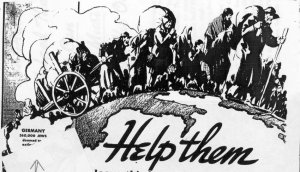 What is learned from the exhibition
What is learned from the exhibition
The 21st Century Jews of Michigan are told that in past times they had to join together to help needy fellow Jews. The message is conveyed that they still need to do so because Jews are always in need, as “anti-Semitism” is always a threat—somewhere. Hasn’t it always been so? Elie Wiesel would approve of this message! [Right: Theme image for the Allied Jewish Campaign, 1938]
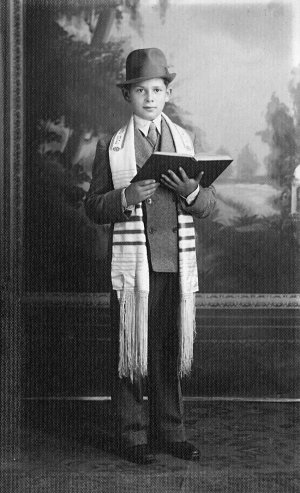 The main thing I notice about this exhibit is that it is totally, 100% about Jews and specifically Jewish concerns. The few non-Jews mentioned are enemies of the Jews. While it starts out saying that by the 1930’s Jews were increasingly comfortable with American ways, it shows nothing about Jews integrating socially with American gentiles and Christians, but only sticking closely with their own kind, their own organizations, their synagogues and businesses. Jews want to be accepted by the majority Gentile culture as “just like them,” but they do not want to participate in the majority Gentile culture, except politically and financially. [Left: Bar Mitzveh Day for Harry Klein]
The main thing I notice about this exhibit is that it is totally, 100% about Jews and specifically Jewish concerns. The few non-Jews mentioned are enemies of the Jews. While it starts out saying that by the 1930’s Jews were increasingly comfortable with American ways, it shows nothing about Jews integrating socially with American gentiles and Christians, but only sticking closely with their own kind, their own organizations, their synagogues and businesses. Jews want to be accepted by the majority Gentile culture as “just like them,” but they do not want to participate in the majority Gentile culture, except politically and financially. [Left: Bar Mitzveh Day for Harry Klein]
It tells us that Michigan Jews were terribly affected by the war in Europe—the spread of Nazism in Europe brought rising “anti-Semitism” in the U.S, and Michigan was not spared! Evil people like Catholic priest Father Charles Coughlin were openly “anti-Semitic” and 30 million non-Jewish Americans listened to his weekly radio broadcasts. [Shown at right speaking over WJR radio in the 1930s] The exhibit particularly excoriates Father Coughlin simply because he warned about excessive power of the Jews. The exhibit shows that Life and Time magazines, and the powerful Detroit Free Press were all on the side of the Jews against Father Coughlin … so where was the problem? Are we dealing with a real threat or with some kind of Jewish agenda here?
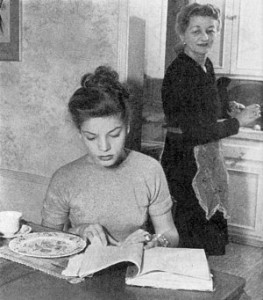
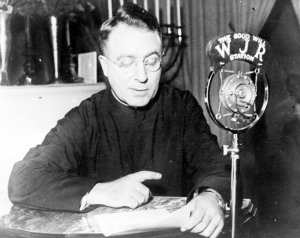
At the same time, Jews like Lauren Bacall [at left as a young woman at home – look at the nose on Mom! Was Lauren given a nose job?] and baseball player Hank Greenberg were given great, positive media attention.
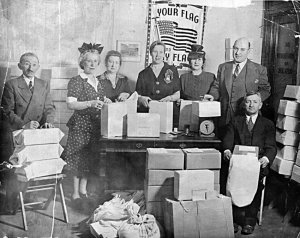 The exhibit tells how the Jews of Michigan supported the war. America’s participation was a wonderful thing. Helping the European Jews was what we should all be doing. Jews like young Harriet Fields collected 381,000 pounds of household waste fat! The Federation of Polish Jews in Detroit [shown right, publicizing their war service] sent packages to the men and women of the Armed Services. The Jewish-owned Paramount Coffee Company of Lansing sent out New Year’s Greeting flyers about the importance of helping one another (without mentioning the war at all, though). The Temple Beth El Bulletin encouraged people to buy war bonds!
The exhibit tells how the Jews of Michigan supported the war. America’s participation was a wonderful thing. Helping the European Jews was what we should all be doing. Jews like young Harriet Fields collected 381,000 pounds of household waste fat! The Federation of Polish Jews in Detroit [shown right, publicizing their war service] sent packages to the men and women of the Armed Services. The Jewish-owned Paramount Coffee Company of Lansing sent out New Year’s Greeting flyers about the importance of helping one another (without mentioning the war at all, though). The Temple Beth El Bulletin encouraged people to buy war bonds!
Jewish organizations made sure they offered social and spiritual support for specifically Jewish soldiers. Beginning in 1942, Jews began protesting a “Nazi Holocaust” of European Jews in Detroit newspapers and in public meetings. The exhibit shows pictures of two whole Michigan Jews who had fallen … they are portrayed as heroes. And it doesn’t leave out that America did not want to take in all of Europe’s Jewish refugees who wanted to come here. It points out everything that the Jews did to help other Jews, and how they got non-Jews to help Jews too.
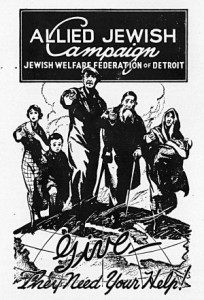 The Allied Jewish Campaign raised money to help Jews. Wow, what sacrifice! “Between 1932 and 1940, its theme shifted from taking care of the needy Jews in the United States to supporting rescue and survival of Jews abroad.” It’s fundraising goal rose from $165,000 to $925,000. Guess who they got most of the money from?
The Allied Jewish Campaign raised money to help Jews. Wow, what sacrifice! “Between 1932 and 1940, its theme shifted from taking care of the needy Jews in the United States to supporting rescue and survival of Jews abroad.” It’s fundraising goal rose from $165,000 to $925,000. Guess who they got most of the money from?
And, of course, “Michigan Jews, especially in Detroit, were active on behalf of building a Jewish homeland in Palestine.” Finally, the stories of four Jewish children who came to the U.S as refugees and are such treasures. Then, MSU’s Jeanette Abeles , Ken Waltzer and Michael Seadle tell stories, with pictures, of their Jewish family history, though none were connected with Michigan. Have we heard enough about Jews yet?
From whence the money comes
This traveling exhibition was made possible with financial support from Congregation Shaarey Zedek of East Lansing, Michigan State University Jewish Studies Program (that’s Waltzer’s domain), Michigan State University Museum, the Michigan Humanities Council, the Ben Teitle Foundation, the Michigan Council for Arts and Cultural Affairs and private donors.
For a fee of $800, plus shipping, the exhibition has been displayed at the following sites so far (according to the website): Northern Michigan University, Marquette, MI; Macomb Community College, Clinton Twp, MI; and Kalamazoo Valley Museum, Kalamazoo, MI.
This “anti-anti-Semitism” project extolling the virtues of Jews is what Ken Waltzer has kept himself busy with in 2013, instead of finishing his book on the children of Buchenwald. What will he come up with next? It’s been clear for some time that the main guiding force for Waltzer is the promotion of Jewry, in whatever way best achieves that goal. Holocaustianity is certainly one way. Heading a Jewish Studies program at a university is another. Working in conjunction with the U.S. Holocaust Memorial Museum is another. And certainly, protecting and promoting the image of Elie Wiesel is also one.
It’s possible, however, that he’s run into a brick wall on Elie Wiesel.
Endnotes:
1. Waltzer admittedly relies on survivor testimony – the least dependable form of “evidence.” In this 2011-2012 Q-A session linked to above, he says:
… my own book, Telling the Story: The Rescue of Children at Buchenwald, will be finished in about a year and will tell the story in much greater detail and more attention to complexity, drawing on information obtained from nearly 200 of those who were helped to survive at the Nazi camp. It will say more about who these boys were, what their experiences were both before Buchenwald and then inside Buchenwald, and where they went and what they did with their memory of experience after liberation. A second book, to be prepared thereafter, will be called Children’s Stories, and will pull together many distinctive stories I’ve been told or have encountered while working on the collective story.
Note that Waltzer is “telling a story” that has been told to him by old men about what happened to them as children. Realize what “story” means to Jews – one is freed from all necessity of accurate fact.
8 Comments
Category Featured | Tags: Tags: Allied Jewish Campaign, anti-Semitism, Charles Coughlin, Hank Greenberg, Jeanette Abeles, Jewish homeland in Palestine, Ken Waltzer, Lauren Bacall, Michael Seadle, Michigan State University,
Social Networks: Facebook, Twitter, Google Bookmarks, del.icio.us, StumbleUpon, Digg, Reddit, Posterous.
Sunday, July 28th, 2013
By Carolyn Yeager
Copyright 2013 Carolyn Yeager
(last edited on 7-30-13)

“How puzzling all these changes are! I’m never sure what I’m going to be, from one minute to another.”
― Lewis Carroll, Alice’s Adventures in Wonderland
Introduction: In Elie Wiesel’s book Night, we find the scenario and characters changing often, and in many cases, with little rhyme or reason that is apparent to the reader. One easily concludes that, like Alice’s Adventures in Wonderland, it is a work of absurdity.
In Lewis Carroll’s classic, nothing makes sense because nothing has to make sense – the intention was to be a “childish” type of foolishness or make-believe from the start. It is an example of literary nonsense (1) genre. Interestingly, we find similar examples of nonsense and absurdity in many of the stories and writings of self-proclaimed “holocaust survivors” – and we put Elie Wiesel into this category. This is why Alice’s Adventures in Wonderland is such a good fit for a parody of Elie Wiesel’s Night.
Cast of Characters:
Elie = Elie Wiesel
White Rabbit = Ken Waltzer
Father = no such person has been found
The King and Queen of Hearts = SS-Totenkopfverbände (SS-TV)
The Duchess = Hilda Wiesel
The Cheshire Cat = Carolyn Yeager
The March Hare = Antonin Kalina, Czech communist block leader
The (Mad) Hatter = Gustav Schiller, Polish Jew block leader
Elie is quite bored one warm afternoon at the Jewish orphan’s mansion in France where he lives. This is not unusual for Elie, who has absolutely nothing to do all day but play chess or study the Talmud or other holy texts of which he is known to be almost fanatically fond. Today, though, no one was around the chess table that had been set up outdoors under a large tree, and Elie becomes a bit dreamy, maybe even sleepy. He is suddenly brought wide awake again when he sees a White Rabbit run by, looking at its pocket watch and muttering “Oh dear, oh dear, I’m going to be late!”
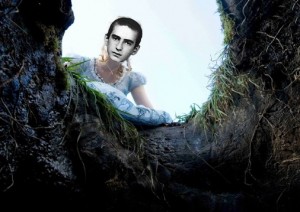 Elie, having never heard a rabbit speak to itself before, let alone have a pocket watch, impulsively runs after the comical creature right into a large rabbit hole. He feels himself slowly falling a long distance before he comes to solid ground. When he does, an unrecognizable landscape of trees, shrubs and creatures such as he has never seen before greets his blinking eyes, and a feeling of being an innocent young girl in an enchanted garden comes over him.
Elie, having never heard a rabbit speak to itself before, let alone have a pocket watch, impulsively runs after the comical creature right into a large rabbit hole. He feels himself slowly falling a long distance before he comes to solid ground. When he does, an unrecognizable landscape of trees, shrubs and creatures such as he has never seen before greets his blinking eyes, and a feeling of being an innocent young girl in an enchanted garden comes over him.
Before he can wonder too much at this, he catches sight of the White Rabbit again and follows him until he is stopped by a barbed wire fence. Standing before it, just the thought of how he might squeeze through the wires to the other side as the rabbit did causes him to shrink to just the right size to step through. As he does—suddenly—he is in a closed railway car with many other people, Jews like himself.
Elie is so unhappy at this turn of events he begins to cry. He cries so much and so hard his tears flood the rail car, making all the others inside very angry, including his own late father whom now, however, seems to be very much alive. As the water made up of Elie’s tears rises closer to the top of the boxcar, the door opens and the inhabitants swim out with the rushing flood.
Appearing for all the world like a catch of wet fish flapping on the platform, the unfortunates find themselves being questioned by a large Caterpillar-looking officer seated on a high stool smoking a hookah. But not one of them is able to answer the officer’s questions as to the particulars of who they are.
“I’m afraid I can’t explain myself, sir. Because I am not myself, you see?”
― Lewis Carroll, Alice in Wonderland
The Camp Buchenland
The hookah-smoking officer tires of their inability to name themselves and, pointing in a certain direction, tells them to march that way to a camp where they will get dry clothes. Once there, the group lines up in an open assembly area and is told they are in Buchenland, the kingdom of the Queen of Hearts who, in spite of her kindly-sounding name, gives orders that must be obeyed. Ordered to now go to the showers where they would also receive the promised new clothing, Elie and Father already fail to obey.
The entrance to the showers is crowded with pushing, shoving people. Father sits down on the ground outside, “I can’t go on anymore; I’ll wait here until we can go into the showers.” As the two lose themselves in an argument over the subject of impending death, the electric lights go out and a loudspeaker commands that all must now be in their assigned barracks.
In haste, Elie follows a crowd into a nearby barracks, where, still unshowered, he falls to the floor and sinks into a dreamless sleep. It is only in the morning that he realizes he is alone; he must have lost his father in the rush to the barracks, and then forgotten about him! Going in search, he wanders about the camp for hours, unmolested by any officers or guards of the Kingdom. Happening upon a place where coffee is being distributed, he gets in line for a cup and magically hears the voice of his father calling to him.
From then on, for the next 7 days (as well as days can be counted in Buchenland), Elie keeps coming back to his father, looking after him in a rather haphazard fashion. Father is not well, not well at all, and Elie, “for a ration of bread,” is able to secure a cot next to his father in the barracks.(2) But a few days later, Elie is sleeping on the upper bunk, above his father, because of his (Elie’s) bandaged foot.(3)
The time comes that Father passes his last breath in his bunk during the middle of the night. According to Elie’s reckoning, it is February 8th-9th, 1945. But elsewhere, Elie states his father died on the night of January 28-29, and again on the 18-19 of Shevat, 5705, which corresponds to February 1st.(4) Elie is both secretly relieved and personally devastated over the loss of Father and blames it on the cruelty of the officials of the Kingdom of Buchenland, calling it murder.
The Queen of Hearts learns about young Elie’s defamations against her health care system, and at the same time the multiple death dates he asserts for his father, and proclaims with great indignation that this cannot be allowed in her Kingdom. The King agrees and they summon the culprit to their presence. After listening to Elie’s disconnected narrative of how he came to be in Buchenland and how he lost his father, she loses patience with the constantly changing versions of his story and shouts “Off with his head!”
Elie is put on trial
Elie is taken to court to be tried for the offense of butchering his father’s date of death. The King and Queen are seated on the high bench. Elie is formally charged with reckless endangerment of the facts of his father’s death. To everyone’s surprise, The Duchess arrives at the court, accompanied by her cat, and asks to testify for the accused. She is granted her request and takes the stand.
You know, [father and son] did a long march from Auschwitz, then they put them on the train to go to Buchen[land]; [Father] died gasping for air. When he stepped off the train, he died gasping for air; at Buchen[land]. But [Elie] knew the date.(5)
The Queen frowns; she is impatient of such testimony that adds even another version of the death in question—what can The Duchess be up to anyway? Then the Duchess’ Cheshire Cat begins to speak, saying the entire court is out of order because the father of the defendant is not the same as the 44-year old man who actually died and is listed in the Buchenland death records; therefore the date that Elie’s father died is irrelevant. Angered to hear it said that her court is out of order, the Queen shouts “Off with his head!” pointing to the Cheshire Cat. As the Queen’s guards move toward the cat to seize him, he cleverly disappears his body, leaving only his head for the spectators to see. How then can his head be chopped off?
Realizing she has been outwitted by a cat, the Queen then turns to Elie and declares him “Guilty! Off with his head!” As Elie is being escorted to the place of execution, he and his guards meet up with the Cheshire Cat again, now sitting in a tree. The Cat advises them to go to the March Hare’s house instead, warning, however, that the Hare is quite mad. “But then, everyone here is mad,” the Cheshire Cat adds with a grin, before he disappears altogether, leaving only his grin still floating in the air.
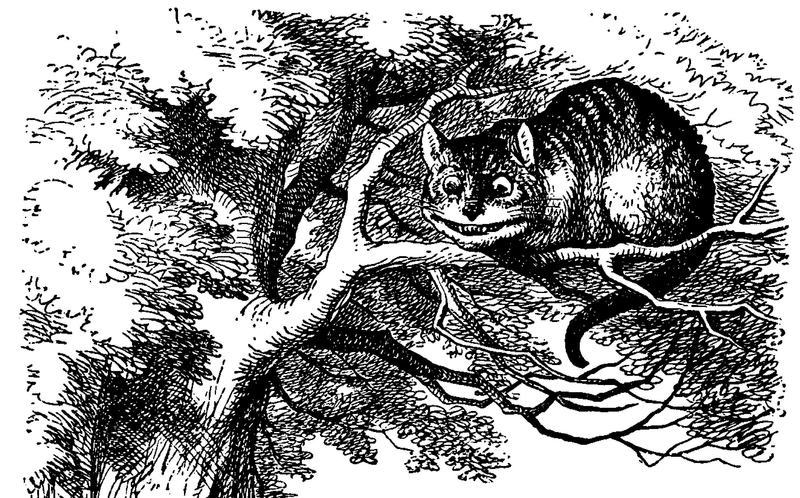
“Who in the world am I? Ah, that’s the great puzzle.”
― Lewis Carroll, Alice in Wonderland
The Hatter’s Tea Party
The White Rabbit is again spotted running ahead as if leading them to the house of the March Hare, which turns out to be another barracks, this one called the “Children’s Block.” Inside, the Hare and his companion The Hatter (also mad—in fact “mad as a hatter”) engage the children in a continual tea party intended to take their minds off the dreariness of their surroundings.
Elie, feeling grateful (for a change) to still have his head on his shoulders, takes a place at the tea table. He is hoping for something good to eat, as he has now lost interest in everything around him except food. But while the Hare and the Hatter provide nothing in the way of food themselves, Elie still finds the tea party routine—one of constantly changing seats, asking unanswerable riddles and reciting nonsensical poetry— much to his liking.
The Hatter has red hair, carries a big stick and likes to boss the children around in his Polish Yiddish. The March Hare is actually of Czech origin and is known to be at his most mad during the month of March, which it happens to be at this very time. Thus do the days pass in the children’s block.
The overthrow of the Queen
However, when the month of April rolls round, the Queen of Hearts discovers that Elie has been hidden in the house of the March Hare and commands the whole place be evacuated. Every day, for several days, Elie is marched to the camp gate with the other children—rumor has it either to be taken away and disposed of or to be given bread and marmalade outside the gate—but every day he is stopped right before the gate and returned to the March Hare’s house. No marmalade and no explanation given.
On the 11th, the enemies of the Queen from outside Buchenland arrive in such great numbers that all the King and Queen’s guards are forced to flee, leaving Buchenland in the hands of the Mad Hatters and the March Hares. In their celebratory mood, on the third day of what they term the “liberation,” they throw open the Queen’s royal pantries and a real party begins. Elie greedily gorges himself on whatever comes first to hand, causing a poisonous shock to his system. He falls unconscious, is taken to a hospital and doesn’t recover for two weeks.
Buchenland doesn’t even notice Elie’s absence. The new owners are busy taking photographs(6), writing publicity propaganda and giving tours of the place. Hunting down every last subject of the former Queen also occupies their attention. The non-descript intruder named Elie (not the only one so named!) is quickly forgotten.
But for this particular Elie, when he awoke again, it was like being reborn. The absurd world he had found himself in after following that White Rabbit down the rabbit hole existed no more; he was back at the mansion in France, unthreatened by any harm. It must have been a dream, he thought. But then, “I shall write about what I remember—now, before I forget. Even though it didn’t really happen, perhaps it could have happened. And since it’s there in my mind like a memory, that makes it real enough! Plus it’s a jolly good story.” So, going inside the mansion, he found paper and pencil and began writing of his amazing adventure in Buchenland, as he remembered it. And he called it Night.
“Why, sometimes I’ve believed as many as six impossible things before breakfast.”
― Lewis Carroll, Alice in Wonderland
Endnotes:
1. Literary nonsense (or nonsense literature) is a broad categorization of literature that uses sensical and nonsensical elements to defy language conventions or logical reasoning.
Nonsense is distinct from fantasy, though there are sometimes resemblances between them. Everything follows logic within the rules of the fantasy world; the nonsense world, on the other hand, has no system of logic, although it may imply the existence of an inscrutable one, just beyond our grasp.
2. “For a ration of bread I was able to exchange cots to be next to my father.” Night, Marion Wiesel translation, 2006, p.108.
3. “The sick stayed in their bunks [during roll call]. My father and I thus stayed inside. He — because of his dysentery and I — because of my bandaged foot. Father was lying in the lowest bunk and I — in the uppermost.” Un di Velt hot geshvign, 1955, p.235.
The bandage refers to the foot operation the fictional Eliezer had before he left Monowitz on or about Jan. 15-16. Could he still be wearing the same bloody bandage he arrived with? Of course not—which means he received treatment that he doesn’t want to tell about.
There is no mention in Night that Wiesel’s foot was still bandaged after 7 days in Buchenwald, and that he could be considered “not fit” for even the ordinary routine. After the march on foot to Gleiwitz, from Auschwitz, Elie never again refers to his foot in Night.
4. http://www.eliewieseltattoo.com/night-1-and-night-2%E2%80%94what-changes-were-made-and-why-part-two/
5. From Hilda Wiesel’s testimony to the Shoah Foundation in 1995. According to the time line in Night, she is speaking of February 1, 1945. According to the official time line, it is Jan. 26, 1945. http://www.eliewieseltattoo.com/night-1-and-night-2%E2%80%94what-changes-were-made-and-why-part-two/
6. Including the Famous Buchenwald Liberation Photo, taken on April 16, 1945 in Barracks #56 while the fictional Eliezer was in the hospital recovering from his fictional food poisoning.
15 Comments
Category Featured | Tags: Tags: Alice in Wonderland, Camp Buchenland, Cheshire Cat, Childrens Block, Elie Wiesel, Hilda Wiesel, Ken Waltzer, Lewis Carroll, literary nonsense, Night, Queen of Hearts,
Social Networks: Facebook, Twitter, Google Bookmarks, del.icio.us, StumbleUpon, Digg, Reddit, Posterous.
Monday, April 1st, 2013
By Carolyn Yeager
copyright 2013 Carolyn Yeager
Updated April 7th
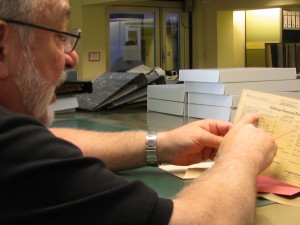
Prof. Kenneth Waltzer is looking at a Buchenwald registration card at the International Tracing Service in Bad Arolsen, Germany.
Kenneth Waltzer is a professor of history at Michigan State University since the early 1970’s. He helped to create the Jewish Studies program which opened in 1992, and which he heads. Waltzer has been researching into evidence of a special ‘boy’s protection program’ run by prisoners at Buchenwald for going on 10 years now. As an “approved” researcher, he is allowed to peruse all the files at the International Tracing Service in Bad Arolsen, Germany, something that is made much more difficult, if not impossible, for revisionists.
Waltzer is considered one of the top scholars in the U.S. of the ill-named holocaust but his work has been sloppy, and his attempts to cover up the sloppiness amount to fraud. This, along with his continual promotion and defense of Elie Wiesel as a Buchenwald survivor, is what has drawn me to study him ever more closely.
Because of the seriousness of the charge I am making against him, I will list right up front my reasons for thinking it is time for such a call. They are:
- Waltzer habitually tells fibs in the form of false information which is intended to mislead. When called out for it, he tells more fibs to cover for the first ones.
- He has been in the service of the “Holocaust Industry,” not academic rigor and fair-mindedness, from the very start of his career.
- He knowingly defrauds his students, his university and the public (you and I) with his dishonest “holocaust scholarship.”
- While he is drawing high pay as a tenured American professor of history at MSU, he is working to advance the State of Israel.
I am going to show that these charges have a strong basis in fact. Fraud is commonly understood as dishonesty calculated for advantage. A person who is dishonest may be called a fraud. In the U.S. legal system, fraud is a specific offense with certain features. (see here)
Legally, fraud must be proved by showing that the defendant’s actions involved five separate elements: (1) a false statement of a material fact, (2) knowledge on the part of the defendant that the statement is untrue, (3) intent on the part of the defendant to deceive the alleged victim, (4) justifiable reliance by the alleged victim on the statement, and (5) injury to the alleged victim as a result.
I am not intending to bring legal charges of fraud against Prof. Waltzer, but to try him in the court of public opinion. Therefore, it will be up to Waltzer to defend himself against my charges.
* * *
Two years ago, I asked the question on this web site: “What happened to Ken Waltzer’s book about the boys of Buchenwald?” It was claimed to be, at that time, in it’s final stages. Eight years after he publicly announced he was researching for a book about the so-called children’s barracks at Buchenwald (Barracks #66 ), it still has not materialized. Five years after his book was described as “upcoming,” it still has not materialized. During this time, he has not produced another book, or any major work that would have taken precedence over this book. So what is the delay?
It’s pretty plain that the book’s thesis has shifted considerably since 2005, when his MSU website featured Elie Wiesel as the most recognizable and famous child survivor from Buchenwald. That website was taken down between one and two years ago and is completely wiped clean from the Internet. The banner on all the six to eight pages that were included showed a photograph very similar to the one below of the “boys” being marched out of the main Buchenwald camp to temporary quarters at the former SS barracks.
The USHMM (national holocaust museum in D.C) website dates this picture as being taken on April 17, 1945, six days after liberation.1 At this time, Elie Wiesel, by his own account in two books, was laying in a hospital sick almost unto death from food poisoning. Details like this don’t deter Prof. Waltzer from backing up in every instance the standard holocaust narrative. “Elie Wiesel in Buchenwald” is the standard narrative, so evidence must be found for it.
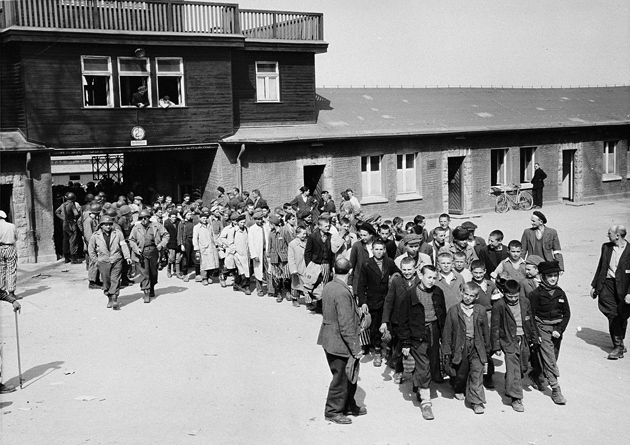 Ken Waltzer claimed for years that one of these boys was Elie Wiesel. But Wiesel is not in this picture!
Ken Waltzer claimed for years that one of these boys was Elie Wiesel. But Wiesel is not in this picture!
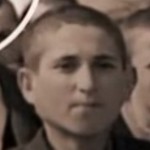 From at least 2005 (eight years now), Waltzer has identified the boy third or fourth from the front (hard to tell) in the left-side column (dressed in a black suit and in front of the tall boy wearing a beret) as Elie Wiesel, based on nothing but his own fraudulent intention that there was enough resemblance that people would believe it if he said so. In this article , I exposed this lie. Waltzer has never admitted that he was mistaken or was perpetrating a falsehood that he intended to put into his book. Instead, what he did when his fabrication was sufficiently exposed was to take the entire site down and not mention it again.
From at least 2005 (eight years now), Waltzer has identified the boy third or fourth from the front (hard to tell) in the left-side column (dressed in a black suit and in front of the tall boy wearing a beret) as Elie Wiesel, based on nothing but his own fraudulent intention that there was enough resemblance that people would believe it if he said so. In this article , I exposed this lie. Waltzer has never admitted that he was mistaken or was perpetrating a falsehood that he intended to put into his book. Instead, what he did when his fabrication was sufficiently exposed was to take the entire site down and not mention it again.
Left is a close-up of the boy Waltzer has maintained for several years is Elie Wiesel. Anyone can tell it is not and that’s why no one else ever publicly agreed with him.
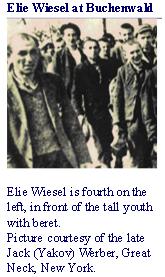 I have some of what was on that site copied into articles here at EWCTW and also in my files. At left is the cropped section of the photo that Waltzer used on the banner of his MSU-Newsroom/Holocaust website that was very much dedicated to Elie Wiesel. (Another reader, Chris, informed me that he had found pages from the site using the Way Back Machine. Many thanks to him.) This shows that Waltzer definitely identified the boy in the black suit as Elie Wiesel. In addition, Jack Werber, a known dishonest survivor, was the supposed supplier of the picture.
I have some of what was on that site copied into articles here at EWCTW and also in my files. At left is the cropped section of the photo that Waltzer used on the banner of his MSU-Newsroom/Holocaust website that was very much dedicated to Elie Wiesel. (Another reader, Chris, informed me that he had found pages from the site using the Way Back Machine. Many thanks to him.) This shows that Waltzer definitely identified the boy in the black suit as Elie Wiesel. In addition, Jack Werber, a known dishonest survivor, was the supposed supplier of the picture.
Below right, a screen shot of one of the pages as it existed then, sent by a friend of EWCTW. It shows more of the emphasis on Elie Wiesel.
When I pointed out much of this in a podcast of March 25th, Waltzer sent me an email on March 28th stating,
My websites at UM FLint are down because I was appointed there one year and am now back at Michigan State.
Of course I never mentioned UM Flint and never even saw his website there. I was speaking about his MSU website, which was titled something like Ken Waltzer’s “MSU Newsroom Special Report.” It was full of information about his projects and especially what he calls “the rescue operation of children at Buchenwald.” It was up on the Net since at least 2008 2, then suddenly disappeared, with not even cache pages to be found. Did Waltzer tell me a fib, or did he just read the podcast program description and misinterpret what it said about “taking down web pages?” By now, he will know what I mean and may answer.
 I think it is very possible that he timed the take-down of his MSU “Newsroom” site with his one-year visiting professorship at UM Flint — putting up a temporary website there which he could take down when he left. This is a way of confusing the picture in order to distract as much as possible from his more recent decision to put more distance between himself and his prior (false) assertions about Elie Wiesel.
I think it is very possible that he timed the take-down of his MSU “Newsroom” site with his one-year visiting professorship at UM Flint — putting up a temporary website there which he could take down when he left. This is a way of confusing the picture in order to distract as much as possible from his more recent decision to put more distance between himself and his prior (false) assertions about Elie Wiesel.
His intention was and is clearly to deceive. The harm is caused to ordinary people who believe and trust that they are getting knowledgeable answers from a professor of history and a holocaust scholar. In this particular case, all five of the elements necessary to prove fraud are there.
First, he sets up a University-sponsored website maintaining falsely that Elie Wiesel is the boy in the photograph of youthful “survivors” marching out of the camp (1). He knows it is false because he has no evidence or proof, only his own “wishful thinking.” The USHMM never identified Wiesel in that group of boys, nor did anyone else (including Wiesel himself), unless they did so from following Waltzer’s example (2). Waltzer’s intent was to make the public believe something that was not true – that he had proof of Elie Wiesel being one of the “rescued children” (3). Because Waltzer is a Professor of History and “holocaust expert” at a major university, and is at all times written up very favorably in the media, the public (you and I ) and his students will rely on his statements (4). These same students and public are injured when photographs are mislabled in order to foist on them a certain belief about an influential historical event that affects their entire world view (5).
* * *
This is just one instance of the untruths that Ken Waltzer has told over the years. Another tactic he uses is to promise an upcoming answer to your doubts which he cannot or does not produce now. As we have seen, we continue to wait as he continues to promise. Still another tactic is to accuse others of lying when it is he who is doing so. But only people who are knowledgeable enough about these complex and purposely obscured issues can see who is doing the lying. In this same email, he wrote:
The book is on track, and I have also completed a separate essay to be published on Elie Wiesel and Buchenwald.
Completed, he says. And separate. Why separate? I wrote back to him asking where I could find his essay because I wanted to read it. No reply – which is typical because factual information is not his forte, emotional rhetoric is. I feel it’s quite possible he wrote a separate essay on Elie Wiesel so as not to tarnish his book with the false “facts” about Wiesel in Buchenwald. He can always get rid of an essay, if necessary, later – but not his entire book. What might there be in this essay? Will it be the same or quite different from what he wrote in a March 6, 2010 comment at Scrapbookpages Blog, when he said [my underlining-cy]:
For the skeptics [I was using the name skeptic then -cy] and know-nothings who have written in suggesting Eli Wiesel was not in the camps, that Night is purely fiction, you are all dead wrong. The Red Cross International Tracing Service Archives documents for Lazar Wiesel and his father prove beyond any doubt that Lazar and his father arrived from Buna to Buchenwald January 26, 1945, that his father soon died a few days later, and that Lazar Wiesel was then moved to block 66, the children’s block in the little camp in Buchenwald. THese documents are backed up by military interviews with others from Sighet who were also in block 66, and by the list of Buchenwald boys sent thereafter to France. All of this is public domain.
Wishful thinking by Holocaust deniers will not make their fantasies true. While Wiesel took liberties in writing Night as a literary masterpiece, Night is rooted in the foundation of Wiesel’s experience in the camps. The Buchenwald experience, particularly, runs closely to what is related in Night.
Comment by kenwaltzer — November 14, 2010 @ 6:57 am
How much untruth is contained in this, in order to defraud us all in his devoted service to the “Holocaust Industry” and the state of Israel? Plenty. As proof that Elie Wiesel was in Buchenwald, he points to documents for Lazar Wiesel and “his father.” It is even more absurd because Lazar Wiesel’s relative was only 13 years older than Lazar – it was in fact his brother Abram! Waltzer is passing off Lazar for Elie simply on the basis that Lazar also came from Sighet, Elie’s hometown and carries the same name. Sighet was a city of 50,000 or so with a very large Jewish population, and Wiesel was a common name. But the “scholar” who has taken years to research this and still isn’t finished, wants us to believe there can be only one Lazar Wiesel, who is Elie. He attributes the difference in their birthdates to bureaucratic error.
Previously I may have called this stupidity, but now I’m calling it fraud, based on the above-given definition. Of course Waltzer can see the discrepancies here, but he hopes he can convince you not to see them. The Military Interview mentioned with Lázár Wiesel’s name on it also does not have the right birthdate for Elie Wiesel, nor does the signature match Elie’s well-known signature.
Will Waltzer repeat this nonsense in his latest “completed” essay? Notice that Waltzer never fails in the name-calling department, here calling his critics names such as “know-nothings” and “Holocaust deniers.” Several months later, he wrote a similar comment at EWCTW to the blockbuster article: “Signatures Prove Lázár Wiesel is not Elie Wiesel”
by kenwaltzer
On November 14, 2010 at 10:34 am
Contrary to Carolyn Yeager’s wishful thinking, Eli Wiesel was indeed the Lazar Wiesel who was admitted to Buchenwald on January 26, 1945, who was subsequently shifted to block 66, and who was interviewed by military authorities before being permitted to leave Buchenwald to go with other Buchenwald orphans to France. Furthermore, there is not a shadow of a doubt about this, although the Buchenwald records do erroneously contain — on some pieces — the birth date of 1913 rather than 1928. A forthcoming paper resolves the “riddle of Lazar” and indicates that Miklos Gruner’s Stolen Identity is a set of false charges and attack on Wiesel without any foundation.
The promise of a forthcoming paper turned out to be a fib. From Nov. 2010 to now, there has not been any paper. Maybe it’s the essay he mentioned in his March 28th email? “Forthcoming” to Waltzer means up to two and a half years, it seems. That in itself is the sign of an unreliable person.
There can be only one reason Ken Waltzer allows himself to look like a buffoon and a shyster. He doesn’t need to do it to keep his position at Michigan State University. He does it because it is his larger job to keep the Buchenwald atrocity stories and Liberation lies, including the Elie Wiesel myth, alive and well in the mind of the public. He works for purely Jewish interests – I will be writing a future article on the priority, meaning and funding of Jewish Studies programs in American universities. For now, I can add that Waltzer is more of a public relations (PR) worker for the Holocaust Industry, the State of Israel and maybe AIPAC, than he is an honest-to-god academic. Another organization connected to Israel that he serves is Scholars for Peace in the Middle East. He has written four attack-dog articles for them since 2009, functioning in a sort of Abe Foxman-pitbull style.
In Nov. 2009, he attacked Alison Wier as another “know-nothing” because she speaks up for Palestinian rights on college campuses, where she is popular.
In May 2010, he went after John Mearsheimer for calling Israel “an apartheid state” and also took out after Noam Chomsky, Norman Finkelstein, and “the crackpot Phil Weiss.”
Also in May 2010, another target was Judith Butler, who campaigned at the Berkeley campus for the university “to divest from companies making military weapons which Israel employs to commit war crimes.”
In August 2011, he wrote on the Israeli-Palestinian peace process, arguing for Israel’s interests to be well and strongly presented on college campuses.
But this is only the tip of the iceberg when it comes to Walzer’s pro-Israel activities. I will be writing further articles that present the evidence for Ken Waltzer being guilty of fraud in his public writings and during his entire career. Much of it revolves around Elie Wiesel and the Industry’s need to place him at Buchenwald. My position, if you have somehow missed it, is that Elie Wiesel was never at Buchenwald. I am also saying that Waltzer is backing down or “stepping back” from his blatant, dishonest claims about Wiesel, but he can’t back down altogether.
Endnotes:
1. I have also seen it dated April 27 at the USHMM and have used that date in other articles here. Now I have only found this one picture which is very officially dated the 17th. There may have been an attempt to move the date to the 27th so that Wiesel could be in the picture (though he supposedly would not have been released from the hospital until the 28th). It is really too bad the USHMM cannot be relied upon; nor can Yad Vashem. When the museum “researchers” are involved in lying or in complacency, one really has nowhere to turn.
2. http://msutoday.msu.edu/news/2008/mapping-the-holocaust-archive-msu-prof-explores-records-of-nazi-atrocities At bottom of article, it reads “For more information, and to follow Waltzer’s research and read his journal as he participates in the workshop, visit the special report at: http://special.newsroom.msu.edu/holocaust.” This is a link to the website that no longer exists, as you will see if you click it. Now he seems to be pretending it was never there.
11 Comments
Category Featured | Tags: Tags: Abram Vizel, Buchenwald camp, Buchenwald liberation, Elie Wiesel, Holocaust Industry, Israel, Ken Waltzer, Lazar Wiesel, legal definition of fraud, M. Grüner, Michigan State University, Night, Scholars for Peace in the MIddle East, USHMM,
Social Networks: Facebook, Twitter, Google Bookmarks, del.icio.us, StumbleUpon, Digg, Reddit, Posterous.
Monday, September 12th, 2011
By Carolyn Yeager
Proof that the man in the famous Buchenwald photograph is NOT Elie Wiesel.
With the help of the New York Times and the U.S. Holocaust Memorial Museum, Elie Wiesel and his backers did not shy away from criminal deceit by purposely misidentifying an unknown face in this famous photo as belonging to Elie Wiesel.
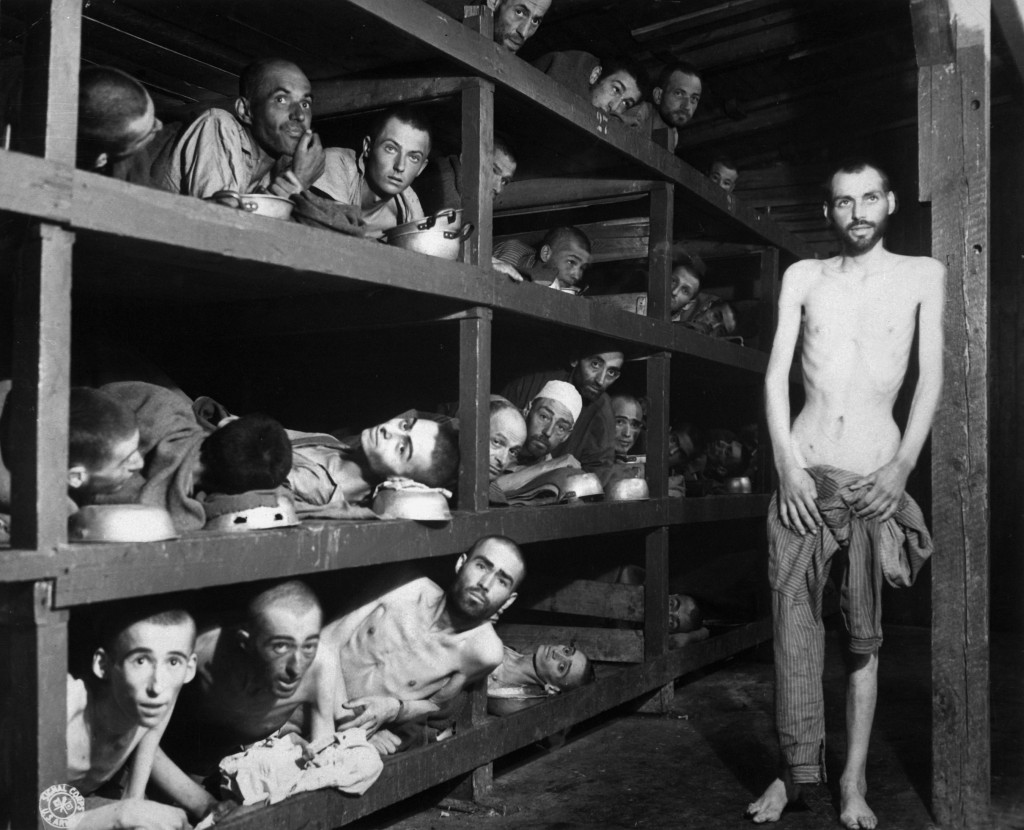
The above high-resolution photograph of Buchenwald survivors was first published in the New York Times on May 6, 1945 with the caption “Crowded Bunks in the Prison Camp at Buchenwald”. [click on image twice to enlarge fully] It was taken inside Block #56 by Private H. Miller of the Civil Affairs Branch of the U.S. Army Signal Corps on April 16, 1945, five days after the Buchenwald camp was liberated by a division of the US Third Army on April 11, 1945. None of the men in the picture were identified at that time.
The U.S. Army photographer was in block #56, not #66
The U.S. Army photographer said he was inside Block #56. The “children’s block” that housed the so-called “boys of Buchenwald” was #66. This was not a typo. Note that these men are not children or teenagers, except for the youngster on the lower left who has been correctly identified as 16 yr. old Myklos (Nikolaus) Grüner, and maybe a couple others. These adults appear to be a mixture of sick individuals suffering from a wasting disease (Grüner learned after liberation he had TB), along with basically healthy men who were also in that block, for some unknown reason, five days after they had been freed. As we have read from many Buchenwald inmates, they moved about at will from the day of liberation onward. In Elie Wiesel’s book Night, he even says that some of the boys in his block went to the city of Weimar the very next day to steal potatoes and rape girls.
The true facts of this photograph have never been told and perhaps are not known. (Grüner has written in Stolen Identity that he left a procession of youths being led to the camp entrance on the morning of April 11, scurried into the nearest barracks and jumped into an empty bunk space. It turned out to be this one.) But because of the man standing there stark naked except for a piece of clothing held in his hands to cover himself, this photograph was certainly staged. In any event, it was never represented as the “children’s barracks.” Still, Elie Wiesel inexplicably once told an interviewer for the German weekly Die Zeit that this photograph was taken in the Children’s Block and all these men were really teenagers even though they looked old. (Source: “1945 und Heute: Holocaust,” Die Zeit, April 21, 1995.)
Kenneth Waltzer wrote to this website EWCTW on Nov. 14, 2010: “Eli Wiesel was indeed the Lazar Wiesel who was admitted to Buchenwald on January 26, 1945, who was subsequently shifted to block 66…” and Waltzer repeated in another comment on June 27, 2011 that “— after his father died — Elie Wiesel was moved in early February to block 66, the kinderblock. Miklos Gruner too was in block 66. Elie Wiesel was there with other boys from Sighet, who knew him.”
But we are also to accept that on April 16 Wiesel was in block 56, even though he didn’t report any such move in his book Night. In fact, in that fictitious story, Wiesel says he became deathly ill with food poisoning three days after liberation (April 14) and spent the next two weeks in hospital (pg 115, Marion Wiesel translation). That in itself precludes his being in this photograph taken on April 16!
Whom do you believe—the New York Times or your own eyes?
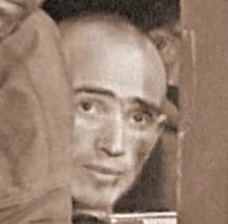
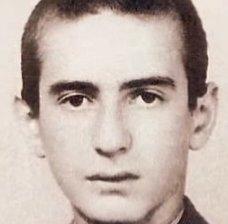 Not Wiesel at age 16 in 1945
Not Wiesel at age 16 in 1945
You can see for yourself from these two high-quality photographs supplied to me by a helpful reader that the face on the left is not Wiesel. A close inspection of the prisoners in the bunks in the famous photograph reveals that the eyebrows on many (including the one on the left above) were emphasized with a dark crayon/pencil … in other words, retouched or “photo-shopped.” On the right is what is claimed to be Elie Wiesel in 1944 at the age of 15.
The inmate on the left definitely has an aquiline nose and full, even sensual, lips. In this close-up, the receding hairline is visible on the recently shaved head. On the right, the real 15-year-old Elie Wiesel exhibits a normal youthful hairline, a bigger and longer nose and thinner lips. He also has a higher forehead and longer face than the more roundish-headed inmate. The eyes of the man on the left are not as deep-set under the eyebrows. His somewhat surprised, curious expression is not typical of Wiesel, whose expression was generally reserved, and often hooded.
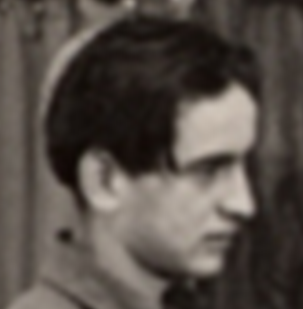
The close-up on the left appears to be the real Elie Wiesel in France later in 1945. He would be 17 or almost 17 years old in this picture. Notice the non-receding, youthful hairline with a very long front lock hanging to the side, and the straight nose .
This close-up image is from the photograph below, which is found at the USHMM Survivor Resource Center with the caption given below. (click here or on lower pic for an undistorted, larger image)
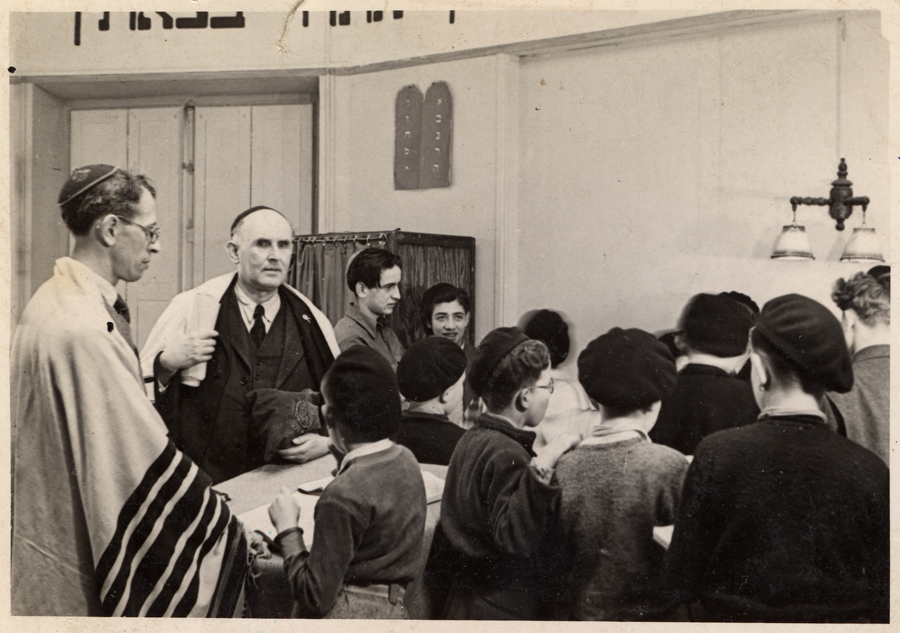
Above, Jewish boys gather for a prayer service in a chapel in an OSE children’s home in 1945. Those pictured include Elie Wiesel (seen in profile) and Jakob Rybsztajn standing next to him facing the camera. (I note that Elie Wiesel is older than the other boys in this picture, giving support to the idea that he acted in the role of counselor and sometime teacher to the newer, younger religious boys.)
Notice again the straight nose, the high forehead, deep-set eyes, large ears, sensitive mouth and slender neck. But also look at all that hair! The date of this picture is given by USHMM as 1945 and the location as Ambloy, [Loir et Cher] France. It says in the accompanying text “In October 1945 the children and staff of Ambloy were relocated to the Chateau de Vaucelles in Taverny (Val d’Oise).” That means this picture was taken between June and October 1945. They could have been celebrating Rosh Hashana, Yom Kippur or Sukkot.
But could his hair have grown to such a length from a shaved head in April 1945? No way, and thus we have another proof that the liberated Buchenwald inmate with the shaved head is NOT Elie Wiesel.
A PDF from my valued contributer examines the ages of the small group more closely. In my opinion, he has the ages of all four men a little too young but especially #2 and 4. Take a look: four men in bunk
Who first identified Elie Wiesel in the famous Buchenwald liberation photo?
In October 1983 the Jewish-owned New York Times published this photograph as part of an article in its high circulation Sunday NYT Magazine with the caption: “On April 11, 1945, American troops liberated the concentration camp’s survivors, including Elie, who later identified himself as the man circled in the photo.”
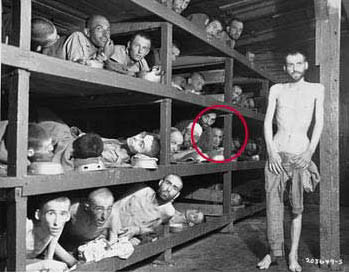
It was also in 1983 that Wiesel’s friend Sigmund Strochlitz began campaigning for a Nobel prize for Wiesel. Letters of nomination are due into the Nobel committee by Feb.1 of each year, so by January 1984, the committee was receiving letters nominating Wiesel from U.S. Senators such as Daniel Moynihan and Barry Goldwater (both Jewish). [see “How Elie Wiesel Got the Nobel Peace Prize“] The effort continued, with new and ever more innovative ideas, through 1985 and 1986 with the help of Jew John Silber, President of Boston University, Wiesel’s employer. Hundreds were enlisted into the effort.
The 1983 article in the New York Times that was the opening gun of the campaign was written by Jew Samuel Freedman and titled “Bearing Witness: The Life and Work of Elie Wiesel.” It included this line: “His name has been frequently mentioned as a possible recipient of a Nobel Prize, for either peace or literature.” Well, it had just begun to be mentioned … by this team of cheerleaders.
Wiesel pretends that he had nothing to do with it. In an interview in France in 2009, he said: “If you fight or if you do scientific research to get the Nobel, you never succeed and you should not succeed.” (Elie Wiesel, “messager de la memoire”) No, he did not fight but his mercenaries fought for him, and he used this photograph as his “research.” That this photograph played a large role is shown by the fact that immediately after the Nobel award ceremony in December 1986, Wiesel went to Yad Vashem Memorial in Jerusalem and posed in front of its prominent display there.
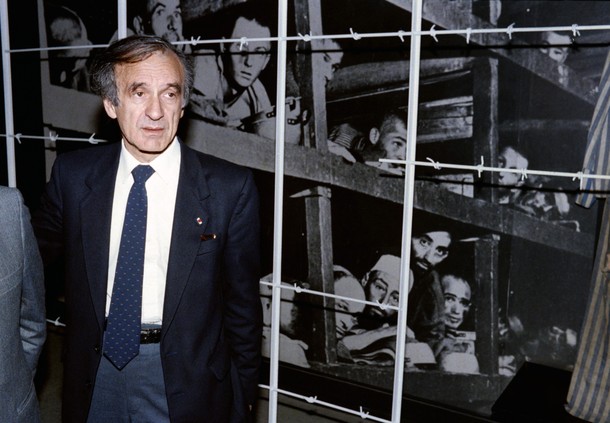
Elie Wiesel on Dec. 18, 1986 at Yad Vashem in Jerusalem
After the award was announced by the Nobel Committee, the New York Times published on Nov. 1 a severely cropped version of the Buchenwald photo (below) with the caption: “Elie Wiesel, the winner of the Nobel Peace Prize (at far right in the top bunk) in the Buchenwald concentration camp in April 1945, when the camp was liberated by American troops.” The picture accompanied an article by Jew Martin Susskind titled, “A Voice from Bonn: History Cannot Be Shrugged Off.”
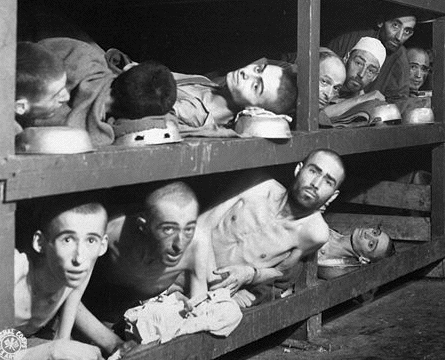
The role played by the tax-payer funded United States Holocaust Memorial Museum
Elie Wiesel finagled his way to becoming Founding Chairman of the United States Holocaust Memorial Council in 1980 after being chosen in 1978 by President Jimmy Carter as chairman of the President’s Commission on the Holocaust. Why the United States needed to do anything at all about the “Holocaust” is something only the 2.5% Jewish population in this country can answer. It is to satisfy them. Wiesel continued to chair the Council until 1986, when he reached his goal of becoming a Nobel Laureate. The USHMM was undoubtedly an important institutional heavyweight that leveraged him to the Nobel.
The USHMM naturally accepted that Wiesel was in the famous photograph as soon as he and the New York Times said he was. If you think the museum staff does real research, is searching for truth and/or is engaged in scholarship of any kind, you are badly mistaken. The museum represents official power only and is invested in keeping it in Jewish hands.
This photograph is the only document tying Elie Wiesel to the Holocaust
The only document that connects Elie Wiesel to the Auschwitz-Birkenau and Buchenwald experience he claims to have—in other words, his claim to be an authentic “Holocaust survivor”—is the famous Buchenwald liberation photograph. There are no records with his name and birth date for either camp. His books do not support his presence there very well. That’s why the Wiesel promoters, who wanted to anchor their man’s claim to be the unchallenged spokesman for the world’s greatest victims—which winning a Nobel prize would surely do—decided that they could pawn that unknown face off as the face of Wiesel. This decision was made in 1983. It’s certain that Elie Wiesel took part in making it, though the pretense is kept up by all that he was aloof from the entire process.
What you must do
When you comprehend the immense power that this simple photo comparison and commentary gives us, you know that we have it in our hands to break down the Wiesel legend if this knowledge is widely circulated. If you understand this, you know what you must do. You must post this article everywhere you can, you must tell everyone about it, send it to all you know … make sure that this photo comparison moves through the Internet and finds a home in as many places as possible. And keep it up, because once is not enough. I’ve done my part, readers. Now it’s up to you.
54 Comments
Category Featured | Tags: Tags: Ambloy France, Block 66, boys of Buchenwald, Buchenwald liberation, Elie Wiesel, Holocaust fraud, Ken Waltzer, Myklos Gruener, New York Times, Nobel Peace Prize, OSE, US Holocaust Memorial Museum, USHMM,
Social Networks: Facebook, Twitter, Google Bookmarks, del.icio.us, StumbleUpon, Digg, Reddit, Posterous.
Tuesday, September 6th, 2011
Edited on Sept. 8, 2011, 4:30 p.m.
By Carolyn Yeager
Another official transport list of the youths sent to France from Buchenwald in summer 1945 has come to my attention. Can it possibly be the “smoking gun” to prove that Elie Wiesel in not one of the “boys of Buchenwald?”
On June 14, I posted a blog on this site questioning “What Happened to Waltzer’s Book about the ‘boys of Buchenwald?’” Professor Ken Waltzer of Michigan State University wrote a comment to that blog in which he stated, “Elie Wiesel was there (in Block 66 at Buchenwald) with other boys from Sighet, who knew him; he was interviewed by military authorities after liberation, in order to permit departure from the camp; and he went after liberation in early June, 1945, to France, to Ecouis…. one among 425 boys who did so.”
Prof. Waltzer has for years been firm in his insistence that Elie Wiesel was on the transport to France from Buchenwald, as one of the “boys of Buchenwald,” a legend in the making. This is largely based on a document containing the name of Lazar Wiesel of Sighet, born Oct. 4, 1928, on the transport list of over 500 Jewish “orphans” from Buchenwald to Paris dated 16th July, 1945. (Note: Elie Wiesel’s official birth date is Sept. 30, 1928)
Page 9 of this list, as well as the cover page, as received by Myklos (Michael) Grüner from the Buchenwald Gedenkstätten (Archival Records Office) is viewable on Elie Wiesel Cons The World under “The Evidence” on our menu bar (click on “The Documents” and then the link at #14). You will notice on that page that number 405 is WIESEL, Lazar.
HOWEVER … it has come to my attention from a helpful, dear reader that at the website of the American Jewish Joint Distribution Committee (http://www.jdc.org) (AJJDC) we find the same list only now it is titled “Orphan Children from Buchenwald now in Paris” –Convoy of 8th June, 1945.”
Here we see number 405 listed as WIEZEN instead of WIESEL. To get two letters in a single surname wrong seems unlikely, especially when it’s connected to a birth date that is not Elie Wiesel’s.
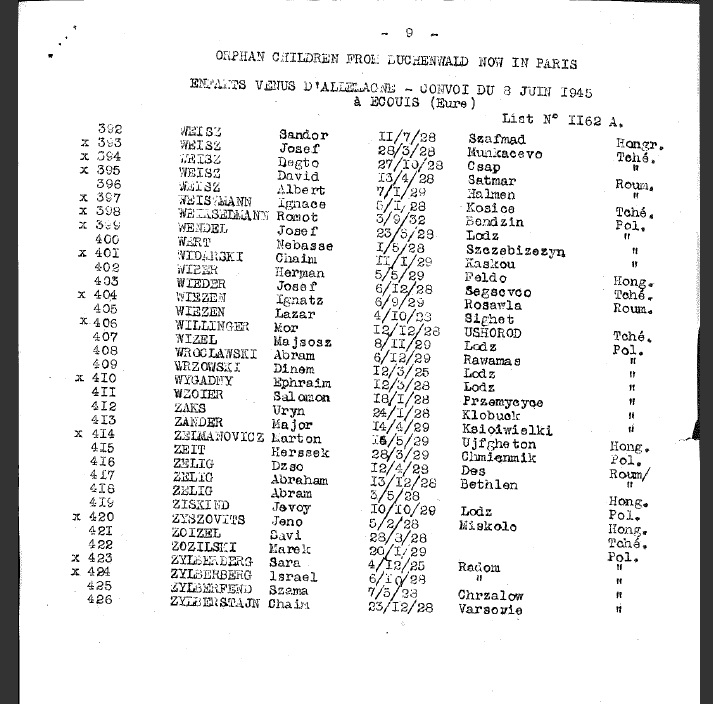
Wiezen or Wiesel?
That the documents are not the same is borne out by the fact that the AJJDC page 9 document above begins with #392 WEISZ, Sandor, while the Buchenwald/Grüner page 9 document begins with #398 WECHSZLMAN, Remet. In addition, there are other differences on this page in name spellings and two in birth dates.
The nature of these differences suggest to me that they may be corrections made in France to the mainly minor mistakes on the list from Buchenwald. This idea is bolstered by the probability that the AJJDC and the Jewish personnel at Ecouis had more interest in and time to spend in learning about each youth’s personal information than did the American Military personnel at Buchenwald, plus they would be more familiar with Jewish/Yiddish names and they would be more concerned with accuracy. There is good reason, when you closely compare the two documents, to speculate that the latter document was typed up in France (AJJDC version shown above) and is the more correct one.
We also have to consider how unlikely it is that the AJJDC would want to tamper with the list to change WIESEL to WIESEN, thus denying that a Wiesel was transported to France from Buchenwald. If any tampering were done, it would more likely be at the other end, at Buchenwald. But I am not charging that … yet.
Confusion over Lazar Wiesel
That said, let’s consider some other aspects. In light of the utter confusion of records for Lazar Wiesel, who arrived at Buchenwald from Auschwitz on Jan. 26, 1945 with a birth date of Sept. 4, 1913 and was given ID number 123565, but who then either got lost or was “reassigned” ID number 123165, which had belonged to Pavel Kuhn, a Slovenian Jew who arrived on the same transport from Auschwitz in January and died on March 8. (See The Documents, # 11, fig. 12.1) The name belonging to this ID number was then given as Lázár Wiesel (with accented “a’s”) who signed the Military Government questionnaire on April 22, giving his birthdate as Oct. 4, 1928 (See The Documents, #11). This is said to be the 16-year-old Lazar Wiesel coming from Buchenwald to France and arriving in Paris on June 8.
This is not at all clear! But now add to it that this person was named Wiesel when he left Buchenwald, but Wiezen after he arrived The rest of his information remains the same. Note also that the signature of “Lázár Wiesel” on the Questionaire is totally different from the signature of Elie Wiesel that is well-known. In addition, the only photograph that claims to be of Wiesel at Buchenwald is provably not Wiesel.
Everything points to an answer that Elie Wiesel was not the one who was at Buchenwald and who traveled to France in summer 1945. As I suggested in a following blog “New Photo of ElieWiesel in France?” he could have arrived in France sometime during the war—helped by the Jewish network and placed in the children’s welfare institutions there.
The ubiquity of the names Lazar and Shlomo Wiesel
I wrote briefly in The Shadowy Origins of Night, Part II that Sighet, Elie Wiesel’s birthplace, had a large Jewish population and that I had counted 19 Eliezer or Lazar Wiesel’s or Visel’s from the small Maramures District of Romania listed as Shoah victims on the Yad Vashem Central Database. Nineteen who died in the “Holocaust”! Just think how many survived and continued to carry and pass on this name. Some were no doubt relatives of Elie’s family. The same is true for Shlomo Wiesel/Vizel—there are many of them in the Yad Vashem database also.
The lesson of this, of course, is that simply seeing the name “Lazar Wiesel” doesn’t mean it is the one and only Elie Wiesel. That different birth dates are given for “Lazar Wiesel” fits this reality perfectly. It’s also true that Elie went by the name of Eliezer, his grandfather’s name, a distinction not without meaning. This will come up again, when I write about Wiesel’s family.~
30 Comments
Category Featured | Tags: Tags: AJJDC, boys of Buchenwald, Ecouis, Elie Wiesel, Ken Waltzer, Orphan convoy,
Social Networks: Facebook, Twitter, Google Bookmarks, del.icio.us, StumbleUpon, Digg, Reddit, Posterous.
Monday, July 18th, 2011
By Carolyn Yeager
Ken Waltzer wrote in his comment on this blog on June 27th:
“More important, Elie Wiesel’s commentary in Night bears fairly close resemblance to the actual experiences he had at Buchenwald—as recorded in camp documents.” (my italics)

What are we to make of the words “fairly close resemblance?” According to Waltzer—and to Wiesel—Wiesel is writing down his own experience. “Every word is true!” Wiesel has said of his book Night. Thus it should exactly resemble the actual experience he had. I’m going to examine closely what is written in Night about Buchenwald to see if that is the case.
It’s not too difficult because the newest English edition of Night1—a new translation by wife Marion Wiesel which changes (corrects) some of the more blatant “boo-boos” found in the original 1960 edition—comprises only 115 pages. Of that, Wiesel’s description of his time at Buchenwald begins on page 104, giving it only 11 pages (one page being blank).
Wiesel wrote a new preface for this new translation in which he tries to answer some of the more common criticisms of his book. His answer to the differences between the Yiddish And the World Remained Silent and Night is that he cut passages he thought might be superfluous … or “too personal, too private, perhaps.” Strange thing to say since he had already published it. Concerning Buchenwald, he quotes the original writing about the death of his father, where the club-wielder is called “an SS” three times! In Night, as you will see below, this person becomes simply “an officer.” Naturally I ask: Did this scene even happen? Wiesel also tries to explain why he cut out from the ending so much of what was in the Yiddish version, but in doing so he leaves unmentioned an extensive part of what he cut. I have quoted these two endings in Shadowy Origins of Night, Part II.
Wiesel begins his experience at Buchenwald by writing that upon reaching the entrance to the Buchenwald camp along with his father and all the new arrivals from his transport, the SS counted them and they were directed to the Appelplatz (roll call area inside the camp) where loudspeakers ordered “Form ranks of fives! Groups of one hundred! Five steps forward!” He then writes, “A veteran of Buchenwald (as he puts it), told us that we would be taking a shower and afterward be sent to different blocks.” He makes it sound as if it were one of those among them, but it actually had to be a Kapo.
He writes that hundreds of prisoners crowded the shower area and made it difficult to get in, therefore his father wanted to find a place to sit down and wait—which he did in a pile of snow where there were other ‘bodies’ sticking out. Dead or alive we’re not told. It’s one of those literary scenes wherein Eliezer confronts Death via his fear of his father’s death. He writes: “This discussion (with his father) continued for some time.” Then … “sirens began to wail … lights went out … guards chased us toward the blocks.” They obviously did not get a hot shower. Wiesel adds: “The cauldrons at the entrance found no takers.” 2
Are we to believe that the kapos, or “veterans of Buchenwald,” allowed non-disinfected, non-showered new arrivals into the barracks, possibly carrying lice and other vermin with them? No way could this have happened. Yet Wiesel writes: “We let ourselves sink into the floor. To sleep was all that mattered.” I guess it was okay because they didn’t get into the beds.
In the morning, having lost track of his father the night before, he went to search for him. What about the regimentation? What about the early morning roll call? Wiesel writes: “I walked for hours without finding him. Then I came to a block where they were distributing black ‘coffee.’ ” 3 He heard his father’s voice asking for some coffee. He brought it to him. “He was lying on the boards,” meaning, I suppose, a bare bunk. Then, “We had been ordered to go outside to allow for cleaning of the blocks (barracks). Only the sick could remain inside. (If that was the case, they were not fumigating.) We stayed outside for five hours. We were given soup. When they allowed us to return to the blocks, I rushed toward my father” … who told Eliezer he had not been given any soup because “they said we would die soon and it would be a waste of food.”
Apparently, he stayed with his father in that barracks, making sure he was fed. Were they allowed to live in whatever barracks they chose? Again, there is no explanation given for this. He then writes that on the third day after their arrival everybody had to go to the showers, even the sick. Having done that (with no description of the process at all), they again had to wait “a long time” outside the barracks while they were being cleaned.
He fills a couple of pages with scenes of watching his father deteriorate amidst all the heartlessness. Then, after a week, a Blockälteste (block warden) told him he couldn’t save his father and he should help himself by eating his father’s rations. Instead, he pretends to be sick so he can stay in the barracks with his father. He doesn’t go to roll call. Now comes the famous passage in which he writes: “In front of the block, the SS were giving orders. An officer passed between the bunks. My father was pleading: “My son, water…I’m burning up…My insides …” The officer shouts at him to be quiet, walks over with a club and hits him “a violent blow to the head.” On that night, January 28, 1945, his father allegedly died.
The main problems with reality in this passage are:
1) The SS is known to have not been active inside the camp; the prisoner-trustees, usually communists, took care of giving the prisoners their orders. So the SS would not be in front of the block giving orders.
2) “An officer” can only be an SS officer. But they never came inside the barracks. Inmates, no matter how much “in charge” they might be, were not called officers. So who was this mysterious “officer” who was inside the barracks? Not SS at all; just part of the fiction and another attempt to assign brutalities to the SS.
Eliezer says he did not weep for his father. He was numb. He was transferred to the children’s block, where he remained with 600 others until April 11. That’s two and a half months, yet he tells us nothing of that time except that he did have an appetite and his only interest was getting an extra ration of soup. On April 5 (he knew the exact date) “we were inside the block, waiting for an SS to come and count us. He was late. Such lateness was unprecedented in the history of Buchenwald.”
Same problem as above: the official story (and Waltzer’s story) tells us that the communist “veterans” had these boys hidden away in the “small camp” where they cared for them, keeping them away from the SS and the camp authorities. We know that the SS did not go inside the blocks. Yet Wiesel writes that they did every day because on this day they were late. Covering for Wiesel, Waltzer writes on his website:
…the 16-year old Wiesel was assigned to a special barracks that was created and maintained by the clandestine underground resistance in the camp as part of a strategy of saving youths. This block, Block 66, was located in the deepest part of the disease-infested little camp, a separate space below the main camp at Buchenwald that was beyond the normal Nazi SS gaze (the local SS officer actively cooperated and conducted appels inside the barracks).
The barracks was overseen by block elder Antonin Kalina, a Czech Communist from Prague, and his deputy, Gustav Schiller, a Polish-Jewish Communist originally from Lvov. Odon Gati, a Communist from Budapest, was stubendienst. Schiller, who appears briefly in “Night,” was a father figure and mentor, especially for the Polish-Jewish boys and many of the Czech-Jewish boys, but he was less liked, and even feared, by Hungarian- and Romanian-Jewish boys, especially religious boys, including Wiesel. He appears in “Night” as a menacing figure, armed with a truncheon.
First, Waltzer mentions the underground. But they did not have the power to hide away the youths who were assigned to the special barracks 66. It was a policy of the Camp Commandant to separate these children to keep them safe, to feed them as well as possible, and they were fully aware of the children’s barrack 66 where they were kept. Thus. there may have been a “local SS officer” assigned to look after Block 66 to make sure everything was being done according to regulations … that is, even to supervise, to some extent, the communist block leaders. The story that it was the communists who “saved these boys from death” is a fiction that was created later, after the liberation of the camp and the formation of the Buchenwald association which was made up of former prisoners of communist persuasion. It was the camp authorities who made the decision to place the “children” away and apart from the adult prisoners, not the underground resistance.
Second, Wiesel writes in Night, “Gustav, the Blockälteste, made it clear with his club” that they had to obey the order to gather in the Appelplatz. Doesn’t this imply that the communist overseers were not necessarily acting as “father-figures” and mentors, but simply as guards? Also note that the kapo Gustav was carrying a club and used it, while earlier it was an “officer” in the barracks who wielded a club against Eliezer’s father. Relative to this, Ferenc Kornfeld reports : “Without exception, the Kapos all had big sticks.” He also said a Kapo armband went with a double food ration. And, “They continually shouted and they hit people on the head and the neck.” Kornfeld wrote about Buchenwald: “There were common criminals, murderers and thieves, in concentration camps too. They were called the “Blockältesters”. They were the “Kapos” (bosses). As they were murderers, they had black triangles on their uniforms. The Kapos hit and slapped all of us.” So much for the idea of Blockälteste’s as mentors.
The abrupt ending of Night
Wiesel claims on pages 114-15 (the last two pages of the book) that on April 5 everyone, even the children, were ordered to gather in the Appelplatz. On the way, some prisoners told them to go back because the Germans planned to shoot them. They turned around and on the way back they learned that “the underground resistance of the camp had made the decision not to abandon the Jews and to prevent their liquidation.” What kind of nonsense is this? Well, it is “the story” which evolved that these communists at Buchenwald finally, on the very last day, fought the Germans. What really happened was the Germans were ready to abandon the camp on the 11th, which they did. Wiesel simply picks up that official fiction of the underground resistance and incorporates it into his narrative. I don’t think the Germans ever intended to evacuate the children and youths.
Apparently, after the 5th, blocks of prisoners were being evacuated to other camps. By April 10, Wiesel writes, “we had not eaten for nearly six days except for a few stalks of grass and some potato peels found on the grounds of the kitchen.” From whom did these potato peels come? Did their communist keepers gather them and bring them to the youths inside the barracks? Did the boys roam around freely and eat grass? At ten o’clock the next morning, he tells us, the SS positioned themselves around the camp and began to herd the remaining inmates toward the Appelplatz. At this point the underground resistance members appeared “from everywhere” with guns and grenades. Eliezer and the other children “remained flat on the floor of the block.” (Therefore they saw nothing.) By noon, the SS had fled and the resistance was in charge. The first American tank arrived at 6 p.m.
Wiesel now wastes no time in concluding the book. He says he became very ill from food poisoning three days later because they “threw themselves on the provisions.” He spent two weeks in the hospital “between life and death.” One day he got up and looked in a mirror and saw only a corpse gazing back at him. This was at the end of April or first of May 1945. Yet he recovered so well that we see a healthy, smiling boy in the picture supposedly taken of him at Ambloy in late 1945 … or is it early or mid 1946?
It’s interesting that Wiesel made such a point later on of maintaining he had vowed in 1945 to wait ten years to write down his experiences. The reasons given, including that his memory would be sharper after ten years, are completely bogus—especially since his book bears little resemblance to the actual camps as we know them to be. The much longer Yiddish version was published in 1955-56. The abridged French version La Nuit in 1958; the English Night in 1960.
Conclusions
I have to say Wiesel doesn’t describe Buchenwald at all. You don’t know anything about Buchenwald from reading Night. You don’t learn much about Eliezer or anyone else. You are given an impression of suffering, without rhyme or reason, so Buchenwald becomes synonymous with suffering, that’s about it. We don’t know what it looks like. We don’t know the name or the physical appearance of any person, not even Gustav carrying a club, who is said elsewhere to have had red hair. Wiesel makes up a story about “an officer” using a club in the barracks when it could only be a kapo (if it was anyone at all). He doesn’t tell us anything about the children in the barracks where he stayed for 2 ½ months. He doesn’t describe the few days after liberation, before he got sick. One did not have to be at Buchenwald to write what he wrote!
Ken Waltzer also writes at his website:
Elie Wiesel has acknowledged the role played by the clandestine underground and political prisoners in saving children and youth at Buchenwald, especially in his autobiography, but he did not attend to this in “Night.” It was not his purpose or focus in that book. Many of his fellow barracks members, however, who are still alive and remember very well their days and nights in Block 66; their relations with Kalina, Schiller and others; and the hope provided to them there, have been helping fill in the story.
You can see a couple of these fellow barracks members here: Scroll down for Excerpts from the “Boys of Buchenwald” discussion panel (7.45 minutes) You can judge for yourself how impressive they are…or not. Neither one mentions Elie Wiesel.
Endnotes:
1. Elie Wiesel, Night, Hill and Wang, New York, 2006, 120 pgs.
2. This can refer to soup or disinfectant being available at the entrance to the barracks. Obviously, Eliezer and his father dawdling by having their long conversation caused them to miss out on both shower and whatever was in the cauldrons. Just another example of the intended vague descriptions permeating this book.
3. In the book, “coffee” is in quotes signifying it wasn’t real coffee. I left off the quote marks in the original writing because of the quote mark signifying the end of the sentence. Poor judgement on my part, but whether it was real coffee or not wasn’t the focus of my attention in this critique. However, the sharp attention of the author of the Scrapbookpages Blog picked up on this and wrote about Wiesel’s failure to know that real coffee was not served in the camps. My apology to “Furtherglory” for misleading him and to my readers also. I have added the quote marks since reading the blog at Scrapbookpages Blog.
17 Comments
Category Featured | Tags: Tags: And the World Remained Silent, Buchenwald, Elie Wiesel, Gustav Schiller, Ken Waltzer, Night,
Social Networks: Facebook, Twitter, Google Bookmarks, del.icio.us, StumbleUpon, Digg, Reddit, Posterous.
Thursday, June 30th, 2011
By Carolyn Yeager
(Last edited on July 3 and added to on July 9)
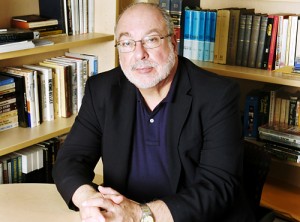 In my previous blog of June 14, I asked the question “What happened to Waltzer’s book about the ‘boys of Buchenwald?’” On June 27, Ken Waltzer (pictured right) answered me … sort of. He said he was not having any trouble with the book, but he didn’t say when we could expect to read it. Not a word on that. But he assured Elie Wiesel Cons the World readers that we will find it a powerful story when we do.
In my previous blog of June 14, I asked the question “What happened to Waltzer’s book about the ‘boys of Buchenwald?’” On June 27, Ken Waltzer (pictured right) answered me … sort of. He said he was not having any trouble with the book, but he didn’t say when we could expect to read it. Not a word on that. But he assured Elie Wiesel Cons the World readers that we will find it a powerful story when we do.
Being a person who likes to stick with the practical and real, I’m not satisfied with Prof. Waltzer’s answer because it avoids the real questions in favor of repeating his claims without supporting them. On top of that, he called me a bigot. This is a grievous fault, it seems to me, in a man who is a Professor of Jewish Studies and German History at Michigan State University. Let’s take a look at what he’s said.
Before writing a comment to my blog, Waltzer first wrote a comment on June 26 to Scrapbookpages Blog. The blogmaster there, who goes by the name of “furtherglory,” had blogged June 16 on my ‘boys of Buchenwald’ article. He checks out new articles about Holocaust on the Internet daily, and seems pretty interested in Elie Wiesel. He added an update to the original blog and asked the question: “Has Ken Waltzer finally figured out that there were three separate people involved in this controversy and all three are named Wiesel.” No, he hasn’t. Waltzer continues to insist that they are all Elie Wiesel.
This is what Ken Waltzer said on Scrapbookpages Blog:
All the ridiculous claims that Wiesel was not Wiesel, Wiesel was not at Buchenwald, Wiesel was a different Wiesel are false, There was one Lazar Wiesel at Buchenwald. He arrived with his father, who appears as Abram, born 1900, and who died shortly after arrival. (He signs his name Shlomo.) Wiesel was then moved to block 66, the children’s block, part of a large child-saving operation by people aligned with the German-Communist led international underground in the camp. He is there with others from Sighet who affirm he is there. He is there until liberation. He is interviewed by American military authorities there. He goes to France.,…
There is no question, indeed there is firm proof, Elie Wiesel was at Buchenwald. And the sections of Night written about Buchenwald are generally accurate and conform to the experience he had.
Comment by Ken Waltzer — June 26, 2011 @ 6:53 am
And this is what Furtherglory said in reply:
Thanks for your comment. A man named Lazar Wiesel was given the tattoo number A-7713 at Auschwitz. A man named Abram Viesel was given the number A-7712 at Auschwitz. Both of them were transferred to Buchenwald in January 1945. Lazar Wiesel, born at Maromarossiget on 4 September 1913, an apprentice locksmith, political detainee and Hungarian Jew, was registered at Buchenwald on 26 January 1945 and assigned the ID number 123565. This must be the man whom you have identified as Elie Wiesel and Abram Viesel is the man that you have identified as Elie’s father. In the records at Auschwitz, Abram Viesel was born on 10 October 1900 at Marmarosz. He was old enough to be Elie Wiesel’s father, but not old enough to be the father of Lazar Wiesel, who was born in 1913, according to the records.
Elie’s full name is Eliezer Wiesel and he was born in Sighet, Romania (Marmarossiget) which was a part of Hungary in 1944. Elie claims he was born on September 30, 1928. Are you saying that his birthdate was mistakenly written as Sept 4, 1913 at Buchenwald?
A man named Lázár Wiesel, (note difference in spelling) born 4 October 1928, was also registered at Buchenwald and given the ID Number 123165. Are you saying that this man did not exist?
You wrote that Elie Wiesel (Lazar Wiesel) was interviewed by the American military. Lázár Wiesel filled out a US Army questionaire on 22 April 1945 at Buchenwald; he stated on the questionaire that he was born at Màromarossziget on 4 October 1928; he was a student who was arrested on 16 April 1944 and interned at Auschwitz and Monowitz. Are you saying that this man didn’t exist?
The records at the Buchenwald Gedenkstätte show that Lázár Wiesel was sent to Paris on 16 July 1945 with a convoy of surviving children and is registered on the transport list. The name Lazar Wiesel is not on the transport list to Paris, which makes sense since he was born in 1913.
Lazar Wiesel’s name was on the transport list from Auschwitz to Buchenwald, but the name Lázár Wiesel was not. That doesn’t mean that Lázár was never at Auschwitz. He could have been sent, from Auschwitz, to some other camp, such as Gross Rosen, and then sent to Buchenwald when Gross Rosen, or whatever other camp, was evacuated.
Comment by furtherglory — June 26, 2011 @ 3:40 pm
It didn’t take furtherglory long to answer Prof. Waltzer and I thought he did a fantastic job. I mean, he’s got it all right and in order and that’s why I’m copying it here … so I won’t have to do it myself. Furtherglory asked Prof. Waltzer some questions, but Waltzer has not yet answered them. I have a feeling he won’t, either, because he doesn’t like to answer questions that he hasn’t posed himself, or are not easy ones. You see, Waltzer spends most of his time talking to his brainwashed students or to Jewish people at Jewish group events, like at the U.S. Holocaust Memorial Museum. Did you know that Jews run that museum and make up most of the attendees at its events? See here. They never ask tough questions.
But still, I was very happy to find a comment on my blog from Prof. Waltzer and I thank him for it. I think it says a lot for him that he is willing to engage, even if only to this extent. He wrote:
by Ken Waltzer On June 27, 2011 at 2:26 pm
Carolyn Yeager suspects that Ken Waltzer is having trouble with his Buchenwald book, esp. proving Elie Wiesel was at Buchenwald as he says he was. Nothing could be further from the truth.
The Buchenwald book is drawn on survivors’ experiences interviewed around the world and on documents from the Red Cross ITS and it will tell a powerful story of endurance and rescue inside Buchenwald.
And related to that larger story, in which Elie Wiesel is merely one of many boys who were helped and saved inside Buchenwald, there simply is no mystery whatsoever of Elie Wiesel, as Yeager claims. He arrived from Buna on a terrible transport on Jan. 26, 1945, with many others (including Miklos Gruner); he was accompanied by his father, who was recorded as Abram (but who signed his name as Shlomo); they were initially together in a barrack in the little camp, 59, I think, and then — after his father died — Elie Wiesel was moved in early February to block 66, the kinderblock. Miklos Gruner too was in block 66. Elie Wiesel was there with other boys from Sighet, who knew him; he was interviewed by military authorities after liberation, in order to permit departure from the camp; and he went after liberation in early June, 1945, to France, to Ecouis…. one among 425 boys who did so. He appears in subsequent pictures at Ambloy and Taverny where the religious boys were taken after Ecouis….
More important, Elie Wiesel’s commentary in Night bears fairly close resemblance to the actual experiences he had at Buchenwald — as recorded in camp documents.
He is the truth teller — Carolyn Yeager; you are the dealer in false claims and bigoted charges.
I am a bigot for doubting Elie Wiesel. I guess it’s some form of antisemitism to doubt that every word Elie Wiesel says is absolutely true … because he is the truth teller, according to Waltzer. And he, Waltzer, is going to prove it.
I consider what Prof. Waltzer is doing similar to ‘sleight of hand.’ He‘s repeating what he’s been saying all along … with a few convenient omissions (for example, the paper proving it he promised 6 months ago). We are to believe that 1) Eliezer Wiesel was listed as Lazar when he arrived, and then as Lázár Wiesel after liberation, with the wrong birth date both times; 2) his father Shlomo was recorded as Abram, also with the wrong birth date; 3) Shlomo is short for Abram or Abraham, not Solomon; and 4) those crazy, mixed-up Nazis got their records wrong.
Has Waltzer managed to falsify some document to show that the elder Wiesel was also known at times as Abraham? We’ll see. Then there is the problem with the pictures. He hasn’t told us which of these boys arriving at Ecouis in France in 1945 is Elie Wiesel. The USHMM tells us Elie is in this picture but doesn’t say where. Can you find him?
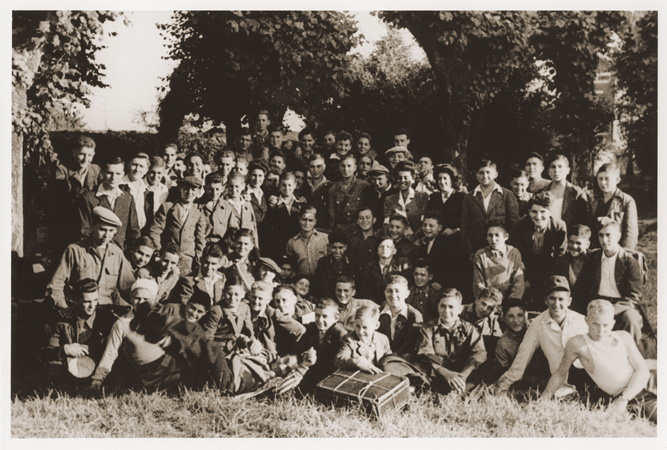
He also didn’t point out to us which of these ‘religious boys’ is Elie Wiesel. He titled it “In France — religious boys, including Elie Wiesel.” But how can we be sure?
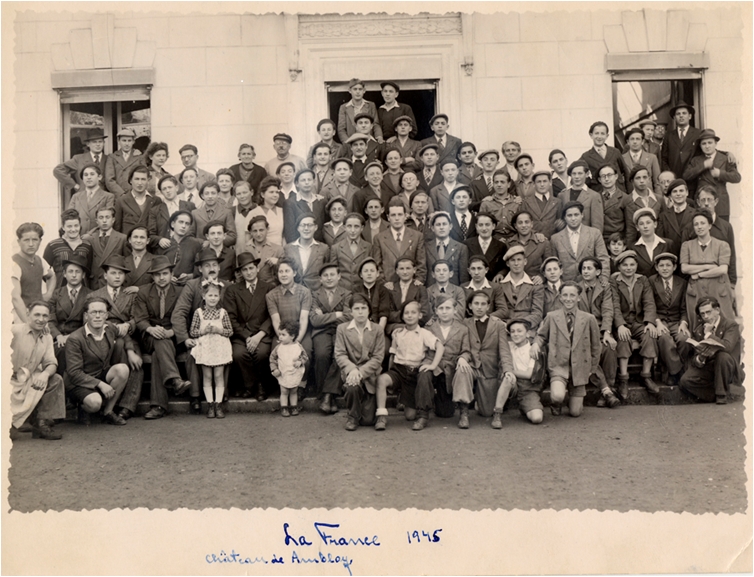
What he seems to be doing is moving the attention away from these pictures to others of Elie Wiesel at Ambloy and Taverny. If there are such pictures I have never seen them. Have they been newly created? Why keep them hidden all these many years? (post note: See Comments #1,2 and 3) Does this mean that Waltzer is now declining to say that Wiesel appears in the famous Buchenwald photo (below)?
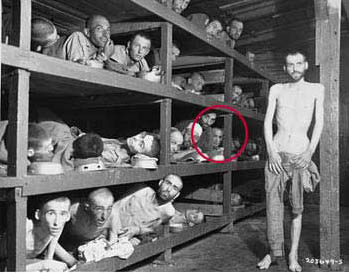
Or in this photo of the boys marching out of Buchenwald after liberation—which he has claimed for several years?
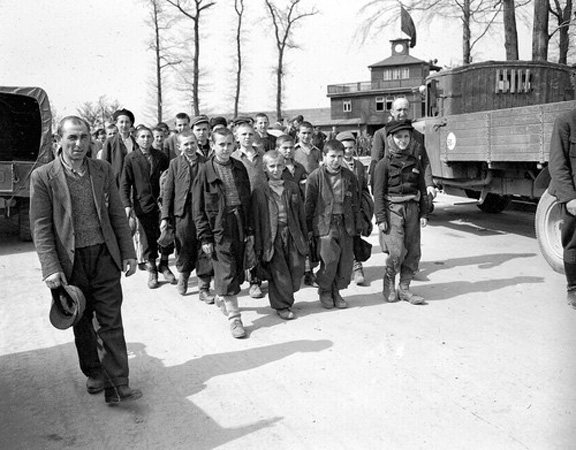
Prof. Waltzer, I know you consider yourself one of the privileged of the world, along with Elie Wiesel, but you must realize that even people of such privilege as yourselves cannot just change Shlomo to Abram as it suits you. When all others who were ‘liberated’ from the German camps are identified by matching their names, birth dates, and prisoner numbers, you cannot decide that in certain cases this formula does not apply and it is YOU who decides who is who.
From your comments, I’m expecting that when your book does finally come out, it will say that Shlomo is Abram and birth dates don’t matter, and this will be a small portion of the book overshadowed by other “powerful” stories of Jewish children. There may be no pictures of Elie Wiesel in France because he is just one of many in your powerful story. It will receive praise, coordinated in advance, from the Jewish media and academic class and no concern whatsoever will be expressed about any contradiction with the facts as they are contained in the Buchenwald archival documents.
But there will be one entity that will not let you alone or off the hook, and that is Elie Wiesel Cons The World website, and maybe some of our readers and followers. So I say—thanks for the comment but we are still waiting and watching for clarification from you.
UPDATE (July 1st):
Shlomo Wiesel was never at Auschwitz or Buchenwald. If he had been at Auschwitz there would be a record for a man named Solomon Viezel or Wiesel born in 1894, who was 50 years old in 1944.
>>We read in Frank N. Magill, ed., “Great Events from History II: Arts And Culture Series: Volume 4, 1955-1969“, Salem Press, Inc., Pasadena, CA., 1993, p. 1700:
“SHLOMO WIESEL (1894-1945), the father of Elie Wiesel“
>>And in in Michaël de Saint Cheron, “Elie Wiesel : L’homme de la mémoire“, Paris, Bayard (coll. Biographie), 1998, p. 25:
“Quant à son père, Shlomo, il ne fut vraiment proche de lui que dans les camps, ces lieux hors du temps, hors de l’espace des vivants, où ils partagèrent le même sort, le même enfer, ou presque.
Son père, né en 1894, à Màrmarossziget, était un juif tolérant et éclairé, alors que sa mère, née en 1898 à Bocsko, cadette de six enfants devenue orpheline de bonne heure, très pieuse, (Translation: His father Shlomo, born in 1894, in Marmarossziget, and his mother, born in 1898 in Bocsko.)
>>More importantly, Elie Wiesel filled out a form for the Yad Vashem Memorial in Israel sometime after the year 2000 (as my memory serves me) stating his father died as a holocaust victim.** On that form, he gave his father’s name as: Shlomo Vizel. He didn’t give a date of birth, but he gave a date of death as Jan. 27, 1945 and the cause of death as: Disease. He signed himself as Eli Vizel, son. That form can be viewed at the Yad Vashem archives online; that’s where I saw it.
Nowhere has Shlomo Vizel (Wiesel) ever been called Abram or Abraham, except now by Ken Waltzer in order to fit with the records for Lazar and Abram Wiesel at Buchenwald.
Stealing real victims and survivors identity is one of the lowest forms of behavior, according to holocaust survivor groups … or so they say. What do you think?
** It should be noted that Elie Wiesel did not fill out Yad Vashem forms for his mother or youngest sister affirming them as victims of the Holocaust. Why not? The logical reason is that he does not have any knowledge that they were indeed taken immediately to a “gas chamber” and killed, as the story has been put out for public comsumption. Even on Wiesel’s main page at Wikipedia it says they were “presumably killed.” That is all. Neither did his two older sisters, who were supposedly at Auschwitz for several months before being transferred to a sub-camp of Dachau, fill out this form for their mother and sister even though they are said to have been all together in the women’s line. These two surviving sisters were totally silent about their WWII experience, in spite of their famous brother, until Hilda, the eldest, gave a videotaped testimony to Steven Spielberg’s Shoah Foundation in the 1990’s.
12 Comments
Category Featured | Tags: Tags: Abram Viesel, Boys from Buchenwald, Carolyn Yeager, Elie Wiesel, Ken Waltzer, Lazar Wiesel, Scrapbookpages Blog, Shlomo Viezel,
Social Networks: Facebook, Twitter, Google Bookmarks, del.icio.us, StumbleUpon, Digg, Reddit, Posterous.
Wednesday, September 22nd, 2010
By Carolyn Yeager
copyright 2010 Carolyn Yeager
Elie Wiesel has been identified – in some cases has identified himself – in these three photographs. A close examination brings up many questions.
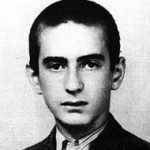
#1 – Elie in 1944, age 15 |
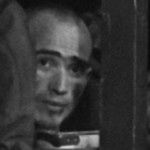
#2 – Elie on April 16, 1945, age 16½ |
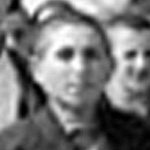
#3 – Elie on April 27, 1945, age 16½ |
Do any two of these pictures look like the same person? You might think that picture #2 or 3 has a vague resemblance to picture #1, but pictures 2 and 3 don’t in the least resemble each other. The man in picture #2 has a sharp aquiline nose, high cheekbones, full lips and looks quite a bit older than 16 years of age, while the round-headed lad in picture #3 has a wide face, short nose and low forehead. He looks younger than 16.
Picture #2 can be recognized as a close-up from the Famous Buchenwald Liberation Photo. [see page under The Evidence]. Weasel has maintained since the 1980’s that this is his face.
Picture #3 is taken from the photograph below. He is the boy in front of the tall boy in the left column of boys leaving Buchenwald, fourth from the front (the third boy in line is hidden from view). He’s been identified as Elie Wiesel by Prof. Kenneth Waltzer on his Michigan State University website. Wiesel has not denied it. The U.S. Holocaust Memorial Museum, however, doesn’t claim that Elie is in this picture (see USHMM below).
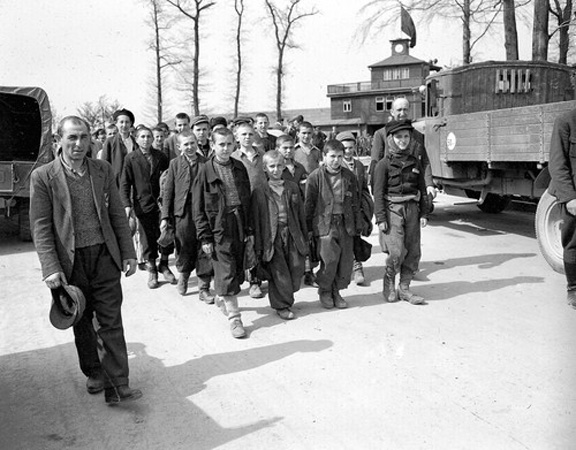
Above: Children march out of Buchenwald to a nearby American field hospital where they will receive medical care. Buchenwald, Germany, April 27, 1945. — Wide World Photo [Photo and caption from USHMM website]
Below: From Ken Waltzer’s MSU Newsroom Special Report page
Elie Wiesel at Buchenwald
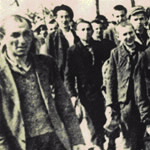
Elie Wiesel is fourth on the left, in front of the tall youth with beret.
Picture courtesy of the late Jack (Yakov) Werber, Great Neck, New York.
Waltzer writes on this same page:
In “Night,” Wiesel says that when he viewed himself in a mirror after liberation, he saw a corpse gazing back at him. But another picture [the one above] taken after liberation on April 17 [he has the date wrong], when the boys were led to the former SS barracks outside the camp, shows Wiesel marching out, fourth on the left, among a phalanx of youth moving together, heads held high, a group together guided by prisoners who had helped save them.
According to Waltzer, Elie Wiesel had a fast recovery to health, body mass and optimism, which Elie himself has never claimed. According to Buchenwald documents, these youths were not sent to France until July 16, 1945 (Fig. 12.4, 12.5),
Waltzer teaches German history and directs the Jewish Studies Program at MSU which includes courses on the Holocaust. He is writing a book about the orphan boys at Buchenwald titled “The Rescue of Children at Buchenwald.” Will Prof. Waltzer offer an explanation in his book for Elie Wiesel’s fit appearance in this photograph? He also accepts the man in the barracks photo as 16-year-old Wiesel. But then he has to, doesn’t he. How will he reconcile these two faces only eleven days apart?
USHMM
The USHMM features the picture shown below on its website—which Waltzer also refers to—and tells us that Elie Wiesel is among these boys without pointing out which one he is. Failing to find anyone who resembles Elie, I wrote to the USHMM asking them to identify him, but received no reply. [Update – because of a reader and also other pictures of Wiesel in France that surfaced later, I now believe Wiesel could be the darkish face in the 2nd to the last row, looking over the shoulder of the boy in a military-looking jacket and to the left of two boys in light-colored caps or berets. ]
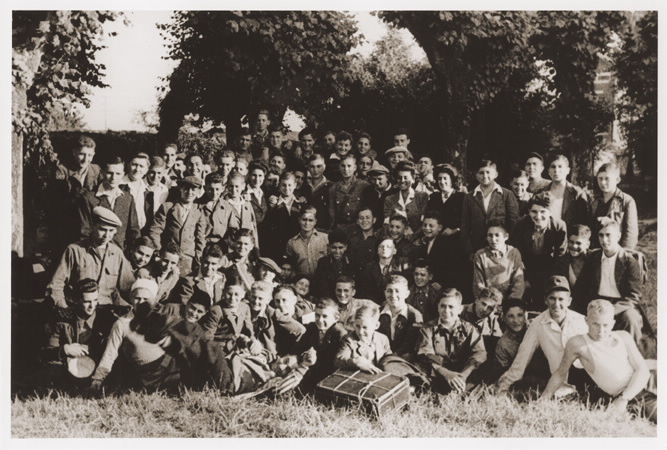 Group portrait of Jewish displaced youth at the OSE (Oeuvre de Secours aux Enfants) home for Orthodox Jewish children in Ambloy. Elie Wiesel is among those pictured. Ambloy, France, 1945. — USHMM, courtesy of Willy Fogel
Group portrait of Jewish displaced youth at the OSE (Oeuvre de Secours aux Enfants) home for Orthodox Jewish children in Ambloy. Elie Wiesel is among those pictured. Ambloy, France, 1945. — USHMM, courtesy of Willy Fogel
The U.S. Holocaust Museum dates this picture simply as 1945. It is definitely summer; the boys are dressed in their suits and “traveling clothes,” as if they had just arrived. A large suitcase is being held by a young boy seated in the front row. It fits in every respect the records for the Buchenwald transport that left Germany for France on July 16, 1945.
Wiesel is careful not to give dates for many important events in his memoir All Rivers Run to the Sea. In this book he writes in detail about his trip to France and his early years with the Oeuvre de Secours. Yet he gives not a single date, until he mentions that he first met his future mentor, Shushani, sometime in 1947.1 He writes of being active with the other Jewish youths – engaged in classes, choir practice, trips and flirtations – but strangely not a single photograph is available.
The next picture of Elie Wiesel I have found was taken in 1949. In fact, it is the first picture of him we can be sure of since the 15-year-old portrait of 1944, prior to deportation (picture #1). Why are there no pictures of Wiesel during all the years he was in the Jewish welfare system in France? We are told his sister Hilda, living in Paris, recognized him in 1945 in a photograph of OSE orphans that was published in a newspaper or magazine. What picture was that? [This question was finally answered. See http://www.eliewieseltattoo.com/another-photo-of-young-elie-wiesel-that-is-not-elie-wiesel/ The group photo above? There are no easy or available answers to these questions. It doesn’t take much imagination, however, to consider that it’s because there aren’t any that “fit” the story.
I find it more than ironic that on the page “Elie Wiesel Timeline and World Events, 1928-1951” there are three photographs and Elie Wiesel is not in any one of them!
The next picture I can find of Elie Wiesel was taken in 1949, on a ship heading for Israel. We see here the real Elie – long, narrow face, long nose (but not aquiline as in picture #2 above), large ears, high broad forehead, a slender build. He is 20 years old and a journalist, and has probably never looked better. [Maybe that’s why the picture was released.] We learn in his memoir that on May 14, 1948, when David Ben Gurion read out the Israel Declaration of Independence, Elie Wiesel had been working already for around six months for the Irgun Yiddish weekly newspaper Zion in Kamf (Zion in Struggle)– yes, Irgun, the terrorist gang. He remained with the Irgun until they closed their European offices in January 1949. He was then persuaded to go where the action was—to Israel. Helped by the Jewish Agency, and traveling with a few Irgun veterans, he boarded the ship Negba in May or June (uncertain), crossing to Haifa, Israel.2 This picture must have been taken during that trip.
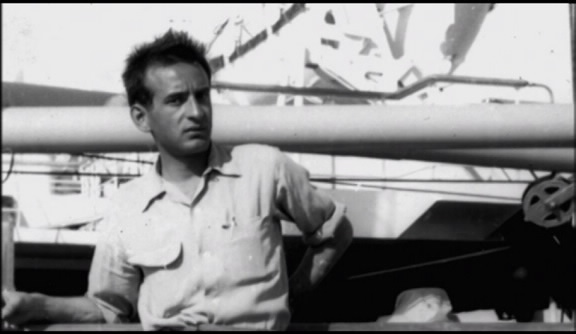 Elie Wiesel on a boat to Israel in 1949
Elie Wiesel on a boat to Israel in 1949
These are the faces of young Elie Wiesel during his “years of travail” that we have at our disposal—not much. I offer the opinion that too much is missing to accept unquestionably the story of his life, during these years 1944-1950, that has been manufactured for public consumption. Only two pictures: before Auschwitz and after his connection with the orphanage was concluded, are definitely him. The search continues.
Endnotes:
- Elie Wiesel, All Rivers Run to the Sea, Alfred Knopf, 1995, p 121.
- ibid, pg. 174-180
14 Comments
Category Featured | Tags: Tags: Buchenwald liberation, Irgun, Ken Waltzer, Oeuvre de Secours, Shushani/Chouchani, USHMM,
Social Networks: Facebook, Twitter, Google Bookmarks, del.icio.us, StumbleUpon, Digg, Reddit, Posterous.














































